Subscribe to The Connexion
See prices & plans
HELP GUIDES
Income Tax in France
Healthcare in France
Inheritance Law and Wills in France
Visas and residency cards for France

Tourism in France: The 2022 trends and outlook for 2023
Camping, theme parks, fewer nights away: we summarise how last year shaped up and look ahead as paris is named the ‘most powerful’ tourist city in the world.

Local breaks, open-air camping, rising hotel prices and the return of (some) international visitors were among the major tourism trends in France last year, new figures show, as 2023 begins with some uncertainty.
Last year was hailed as the ‘return to normal’ for the hospitality sector after two years of chaos due to the pandemic.
Visitor numbers, hotel room occupancy and airport passenger numbers, however, were under 2019 levels. However, the sector still brought in nearly €50billion, the latest report on the tourism economy published by France’s tourist agency Atout France shows.
The major trends included:
Campsites recorded a 7.5% rise in visits compared to 2019.
This was attributed to several factors including people’s desire for nearby, open spaces after lockdown, and lower holiday budgets. The sector is also attracting visitors with higher budgets as campsites and ‘glamping’ venues become more high-end.
Read also: House swapping in France gave us a dream family holiday in Grenoble
Open-air attractions and theme parks
Open-air attractions and theme parks also did well. For example, in Ile-de-France, the Aventure Floréval and Winnoland parks saw visitor numbers rise by 27% and 29% respectively, compared to 2019, figures from the comité régional du tourisme (CRT) show.
In Loir-et-Cher, the Beauval zoo welcomed a record two million visitors in 2022, a rise of 25% compared to 2019.
Theme parks belonging to the Compagnie des Alpes (such as Parc Astérix, and Futuroscope) also saw 10 million visitors; a rise of 6% compared to 2019.
And despite the rising price of tickets, la Compagnie des Alpes said that people were still spending more than normal in the parks’ hotels, shops and restaurants.
Tourists in France were less likely to leave their home region to go on holiday and were also spending fewer nights away, Atout France said. In addition, it found that 44% of people in France did not go on holiday in summer 2022.
It blamed this on the global economic downturn.
Typical Paris sites less popular
Some typical tourist sites in Paris also proved less popular than in previous years, largely due to fewer visitors from Asia. The Louvre saw 20% fewer ticket sales, and Versailles Palace sold 17% fewer.
Elsewhere, Lourdes saw a third fewer pilgrims visit last year than its typical number.
Hotel occupation rates and revenue were also down. Nationwide, revenue was down 4.4% compared to 2019. This may be due to rising hotel bedroom prices, which have risen 14% on average (higher than inflation) due to extra costs of raw materials and energy.
International clients, American and European clients have largely returned to hotels, however, the figures suggest. Yet, business travel has not yet reached 2019 levels, even though it has restarted. In Ile-de-France, professional shows recorded 1.3 million fewer visitors compared to 2019.
Tourism accommodation has recorded high competition from alternatives such as campsites and Airbnbs.
Read also: Tourism tax: €148m paid to French communes from Airbnb stays in 2022
2023 uncertainty
So far, 2023 is looking to be an uncertain year for the sector. Rising costs of energy, raw materials, and even salaries could threaten the survival of smaller, independent hotels.
Recruitment within the hospitality industry is also still proving tough, especially for seasonal jobs.
Paris ranked ‘most powerful tourist city’
It comes as Paris was named the ‘most powerful’ tourism city in the world in a study by British non-profit organisation the World Travel and Tourism Council (WTTC).
The city welcomed 34.5 million tourists in total in 2022. Its ‘powerful’ ranking also came partly due to the investments made in the capital due to the forthcoming 2024 Olympic and Paralympic Games. These included investments in infrastructure and the resources needed to secure the event.
Read also: Paris Olympics 2024: How can I become a volunteer?
The WTTC also considered the amount of money spent by tourists, whether on hotel rooms, or on tourist activities such as museum visits. In 2022, visitors to the city spent a record €35billion.
Beijing, China, came in second place behind Paris. Two other Chinese cities also came in the top 10: Shanghai in 4th, and Guangzhou in 10th. The WTTC predicts that in the next 10 years, all of the top 10 will be in China.
In a press statement, Julia Simpson, president and general director of the WTTC, said: “Major cities like London, Paris, and New York will remain world powers, but over the course of the next few years, Beijing, Shanghai, and Macao will climb in the list of major urban destinations.”
The US also has three entries in the top 10; Orlando, Las Vegas, and New York. These receive significant income due to theme parks, nightlife and gambling, and food and culture respectively.
The amount of money spent by tourists is not the only factor in the list, however. Tokyo, Mexico, and London also figure on the ranking, partly due to their historical significance and recent appearance in the global media.
Dubai and Doha were also included due to this, partly because of the recent football World Cup.
In contrast, the list does not include cities like Amsterdam, Barcelona, or Singapore, despite their high tourist spending.
Related articles
Ski holidays in France: why British tourists shun the train
Normandy wins ‘most desirable region’ for British tourists
tourism french news camping tourist figures

UK jockey gets French residency card meeting after public complaint
James Reveley asked about obtaining a titre de séjour after victory in prestigious ‘president’s race’ in Paris last weekend

Saharan winds bring sands and storms to France this weekend
Rains could last until May 1 bank holiday next week, with no part of the country spared

British retiree in France takes Brexit case to human rights court
Alice Bouilliez and her lawyers will appeal to the European Court of Human Rights after a recent EU court setback
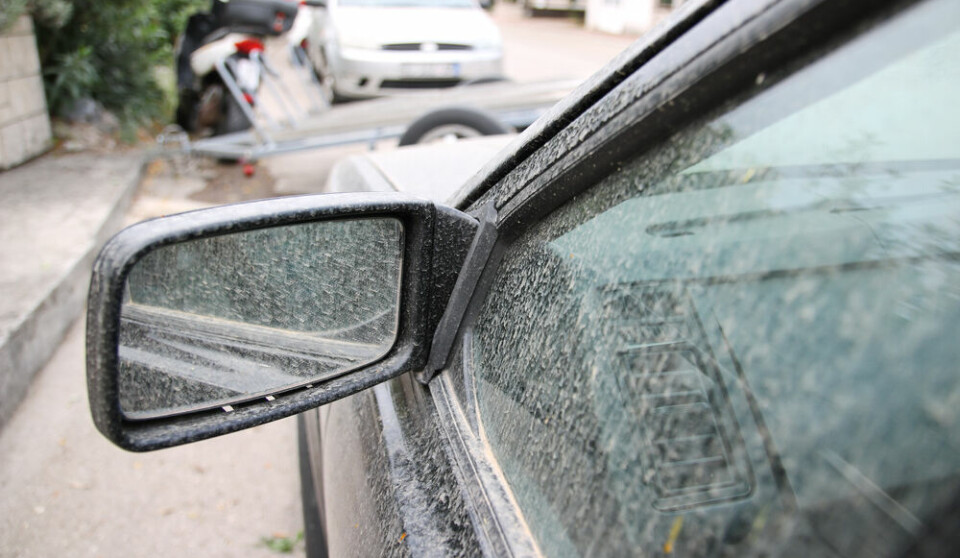
House ruined by wood-rotting fungus - ‘French insurance will not pay’
Why being told to go cook an egg in french is rarely a good thing, more than 31,000 in 2024: spectacular rise in centenarians in france.
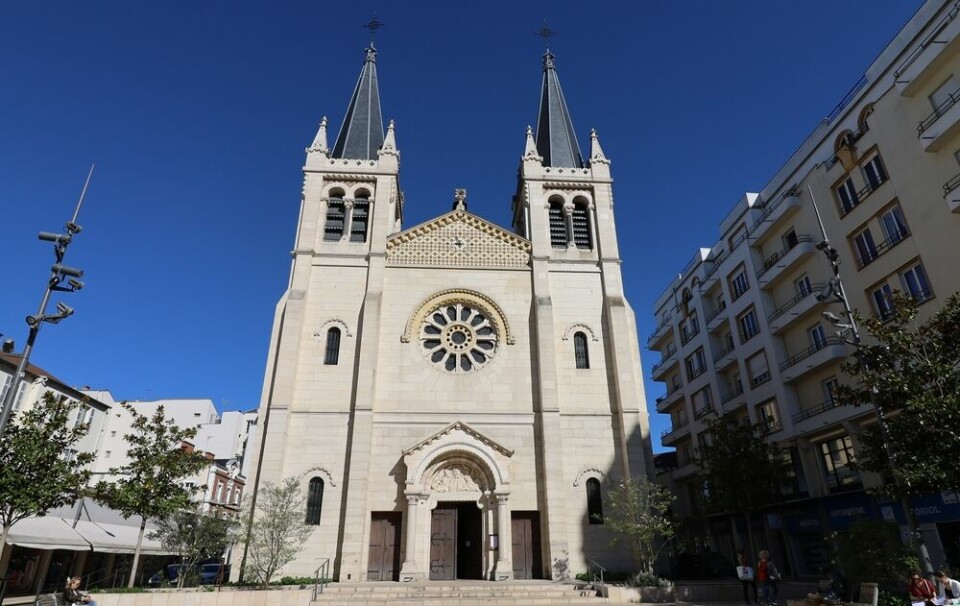
Vichy laws still endure in modern-day France
Legislation introduced by the Vichy regime in World War Two is still being applied in France today, a historian who specialises in the period has pointed out

Career change in France: from police officer to gardener
Amanda Freeman explains how she swapped law and order for a more creative vocation in the French countryside
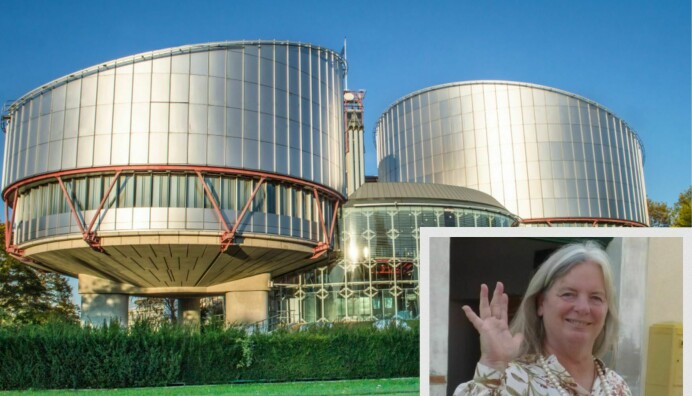
French teenager suspected of plotting terrorist act at Paris Olympics
The 16-year-old had ‘pledged allegiance’ to Islamic State and has admitted his plans

Blades of Paris Moulin Rouge cabaret club mysteriously fall off
It was not a windy night and the blades are checked regularly, say managers

Heat pump insurance cover downgraded for many home owners in France
Wood-burning stoves are also affected following a court ruling

Grass clippings: what to do if the tip does not accept them in France
Rennes metropole is the first to bring in a ban - and has ended door-to-door pick ups - but other areas have followed

Should I include appliances in a French house insurance estimate?
When taking out a home cover policy, you are asked to calculate the approximate value of the property
How does your area of France fare for delay to see a doctor?
Some departments are in particular trouble when it comes to waiting times for specialists
MAP: where and why are there curfews in France? Who is affected?
France to build more reactors as nuclear prioritised, must i declare dividends that are reinvested outside of france.
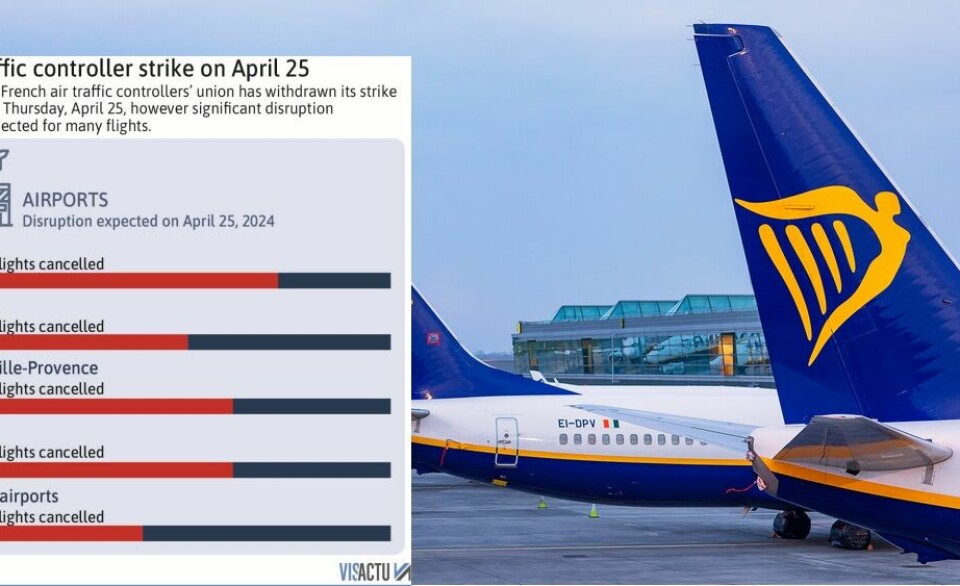
Mass flight disruption at French airports today April 25
Around 3,000 flights are set to be affected despite strike action being called off. A three-day strike notice for May remains in place

What is cost of average funeral in France?
Prices are reported to be similar in France to those in the UK

Stray dogs to be shot after sheep attacks in southern France
But animal welfare campaigners say the dogs should be taken to shelters instead

Eurostar fares revamp and motorway closures: 6 France travel updates
We also look at the launch of new air routes between France and the US and UK and why more and more drivers risk a fine for failing to get their obligatory roadworthiness checks
How to apply for seasonal work in France as a non-EU citizen
Job adverts, work permits and visas - we explain the rules for employees and employers
State of French roads causing alarm
Does everyone in france need to complete an income tax return, must children help to pay for elderly parents in french care homes.

What dental work is covered with the 100% Santé scheme in France?
The scheme was introduced in 2020 and covers those in the healthcare system with mutuelle cover
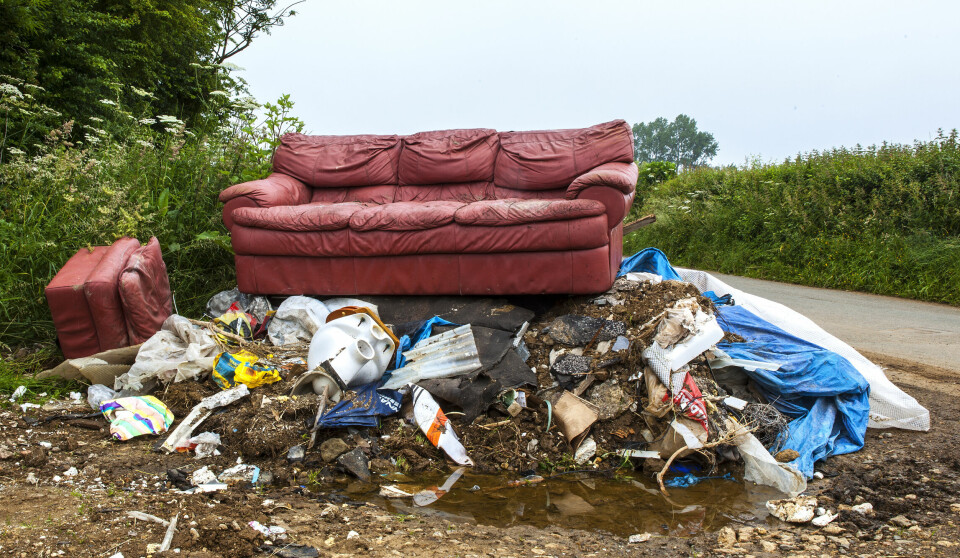
What items can I take to local tip in France? Are any banned?
Déchetteries can accept various types of non-household waste

How do people change when they move to France?
From embracing a sportier lifestyle to keeping their brains sharp

9 ways France plans to simplify bureaucracy for residents
‘Intelligible’ language, more telephone operators, shorter waiting times, and a new AI assistant are among new admin simplification measures announced by the PM
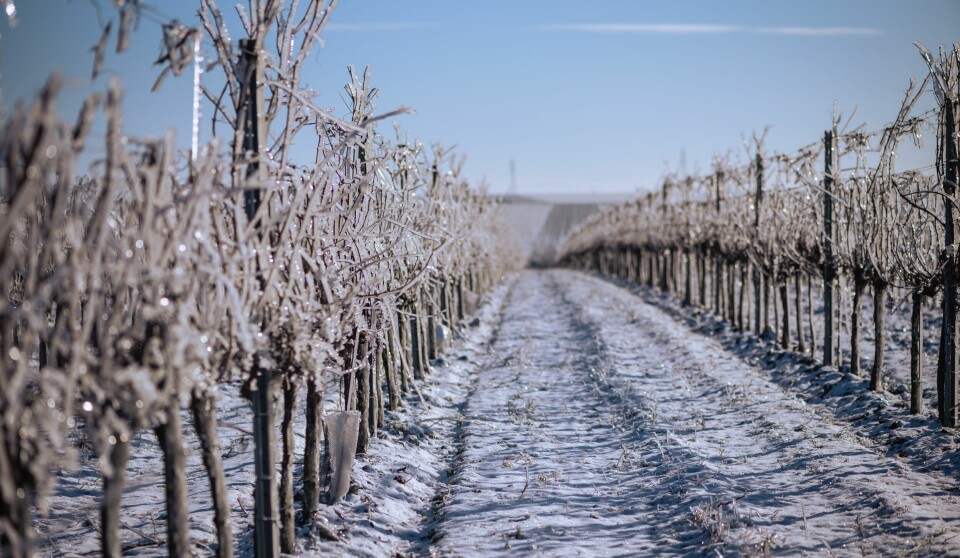
Crops and vines decimated by April frosts in France
Cold snap is predicted to continue until end of week, when a cévenol storm will sweep across country
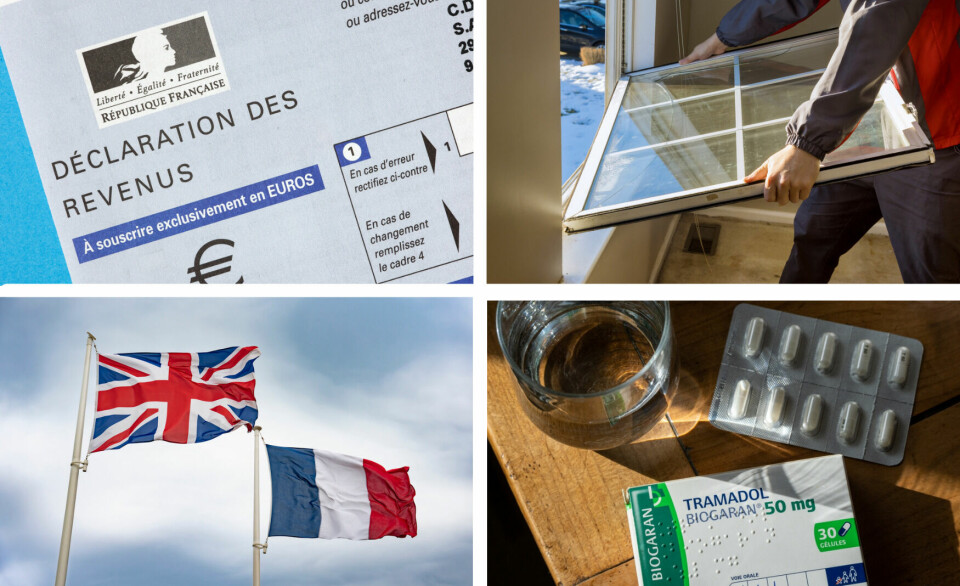
Stay up-to-date: 20 recent and upcoming changes in France
We cover tax updates, renovation scheme revamps, possible money changes for British residents and more
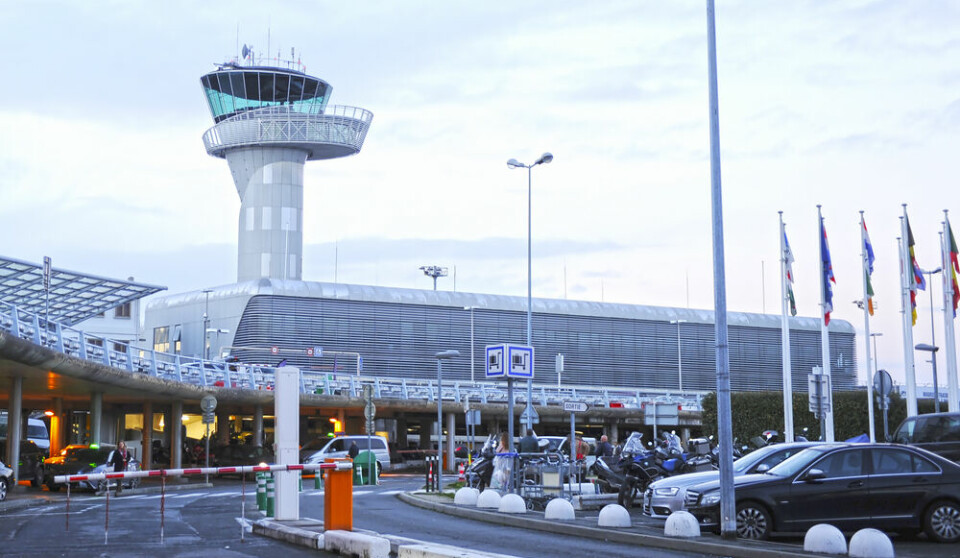
BREAKING: Thursday's air strike in France called off, disruption still expected
Disruption is still expected at a number of airports. The union has also not rescinded its strike notice for three days in May
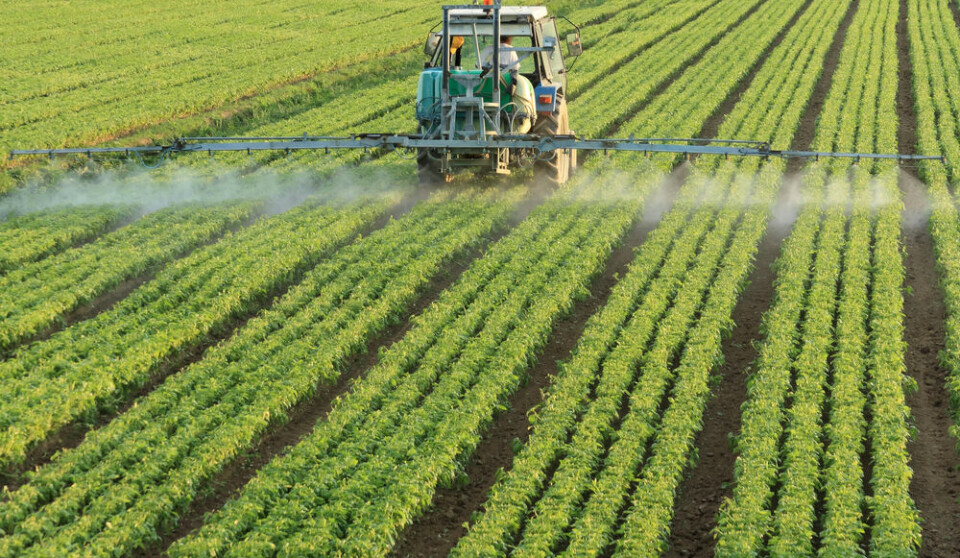
Pesticide poison victims in France asked to join legal action
The aim is to create a compensation fund for residents suffering with illnesses thought to be caused by pesticides
Friday, April 26, 2024 2:53 pm (Paris)
Summer 2022 marks the great return of tourists to France
Initial figures are showing sustained tourism activity in France this summer, similar to 2019. This is being fueled by the high price of accommodation and the revival of France's Parisian engine, driven by Americans.
By Clément Guillou
Time to 5 min.
- Share on Twitter
- Share on Messenger
- Share on Facebook
- Share by email
- Share on Linkedin
Subscribers only
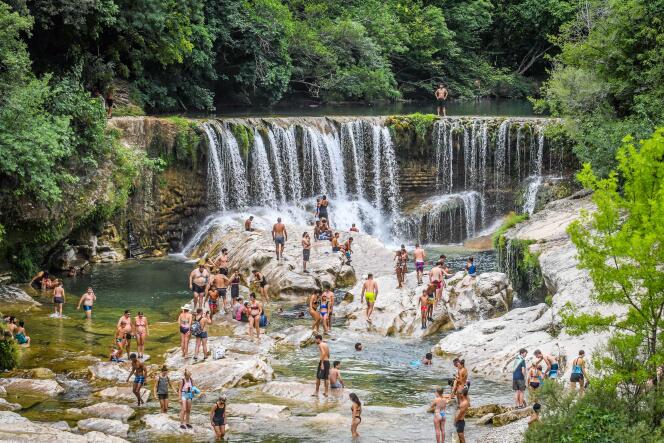
The school bags had not yet been filled and the bathing suits were still on the clothesline when Olivia Grégoire, the minister responsible for tourism, rushed to take stock of a "particularly successful" summer on Monday, August 29. It was something of a premature press conference, given that September is a valuable month for French tourism. Extending summer tourist flows is a priority for the sector.
As the minister – whose portfolio also includes small and medium-sized businesses, trade and crafts – conceded from the outset, there was an urgent need to rejoice. "Good news is quite rare in these times." While the figures have yet to be consolidated, summer tourist consumer activity should help push back the specter of recession, with the sector accounting for around 8% of gross domestic product, and much more in the third quarter. (The ministry claimed, based on an opinion poll, that seven out of 10 French people went on vacation this summer.)
As the levels of bookings and the high number of long-weekend visitors in the spring suggested, those French who can afford it have largely indulged in vacations, despite the high prices and the economic and climatic hazards.
In an anxiety-inducing context, these figures give the summer of 2022 the sense of being a last breath, before a cloud-filled autumn and the return-to-work. The sunny weather throughout the country also encouraged day trips and visits to amusement parks, activities that sometimes act as a fallback solution for households unable to travel far from home.
Cell phone data, analyzed by ADN Tourisme, the umbrella organization of tourist offices, shows a decline in the number of French visitors over the last two summers. French holidays abroad have almost returned to their pre-crisis level, and are above the 2019 level. So are European visits, which are clearly on the rise. More precise and consolidated figures – French tourism is notoriously deficient in this area – will be necessary to determine which territories have benefited from these flows. But the dominant impression is of a return to pre-pandemic habits, with coasts and cities proving a strong draw.
Overall decline in cash payments
Some strong trends that appeared during Covid-19 have been confirmed: local and highland tourism, traveling vacations, peer-to-peer rentals, and travel by bike or train. The SNCF [French national railway] sold 10% more long-distance tickets than in 2019 (15% for TER) [regional transport service].
In contrast, initial feedback from tourist offices suggests a lackluster summer for restaurant owners and for certain outdoor activity industries – they suffered from the heat wave, the economic climate and the lack of staff. In the middle of the season and in seaside resorts, there were empty terraces at noon and restaurants closed one or two days a week.
You have 66.98% of this article left to read. The rest is for subscribers only.
Lecture du Monde en cours sur un autre appareil.
Vous pouvez lire Le Monde sur un seul appareil à la fois
Ce message s’affichera sur l’autre appareil.
Parce qu’une autre personne (ou vous) est en train de lire Le Monde avec ce compte sur un autre appareil.
Vous ne pouvez lire Le Monde que sur un seul appareil à la fois (ordinateur, téléphone ou tablette).
Comment ne plus voir ce message ?
En cliquant sur « Continuer à lire ici » et en vous assurant que vous êtes la seule personne à consulter Le Monde avec ce compte.
Que se passera-t-il si vous continuez à lire ici ?
Ce message s’affichera sur l’autre appareil. Ce dernier restera connecté avec ce compte.
Y a-t-il d’autres limites ?
Non. Vous pouvez vous connecter avec votre compte sur autant d’appareils que vous le souhaitez, mais en les utilisant à des moments différents.
Vous ignorez qui est l’autre personne ?
Nous vous conseillons de modifier votre mot de passe .
Lecture restreinte
Votre abonnement n’autorise pas la lecture de cet article
Pour plus d’informations, merci de contacter notre service commercial.

- Espace presse
Insee Focus · April 2023 · n° 297 Due to the health crisis, the share of tourism in France's GDP falls from 4.1% in 2019 to 3.0% in 2021
Mélanie Chassard (Insee)
In 2021, as in 2020, tourism GDP represented 3.0% of France's GDP. Before the Covid-19 health crisis, it amounted to 4.1% of GDP. The restriction of travel, the mandatory closures have strongly affected the activity of accommodation, transport, restaurants and beverage-serving services, as well as cultural, sports and leisure activities, which are characteristic of tourism. The decline in activity was sharper in tourism in 2020 than in the rest of the economy and was not offset by the recovery in 2021.

Tourism in France
Development of the tourism sector in france from 1995 to 2021.

World famous landscapes
Côte d'azur, loire valley, revenues from tourism.

All data for France in detail


- radicalstorage.com
- Français ( French )
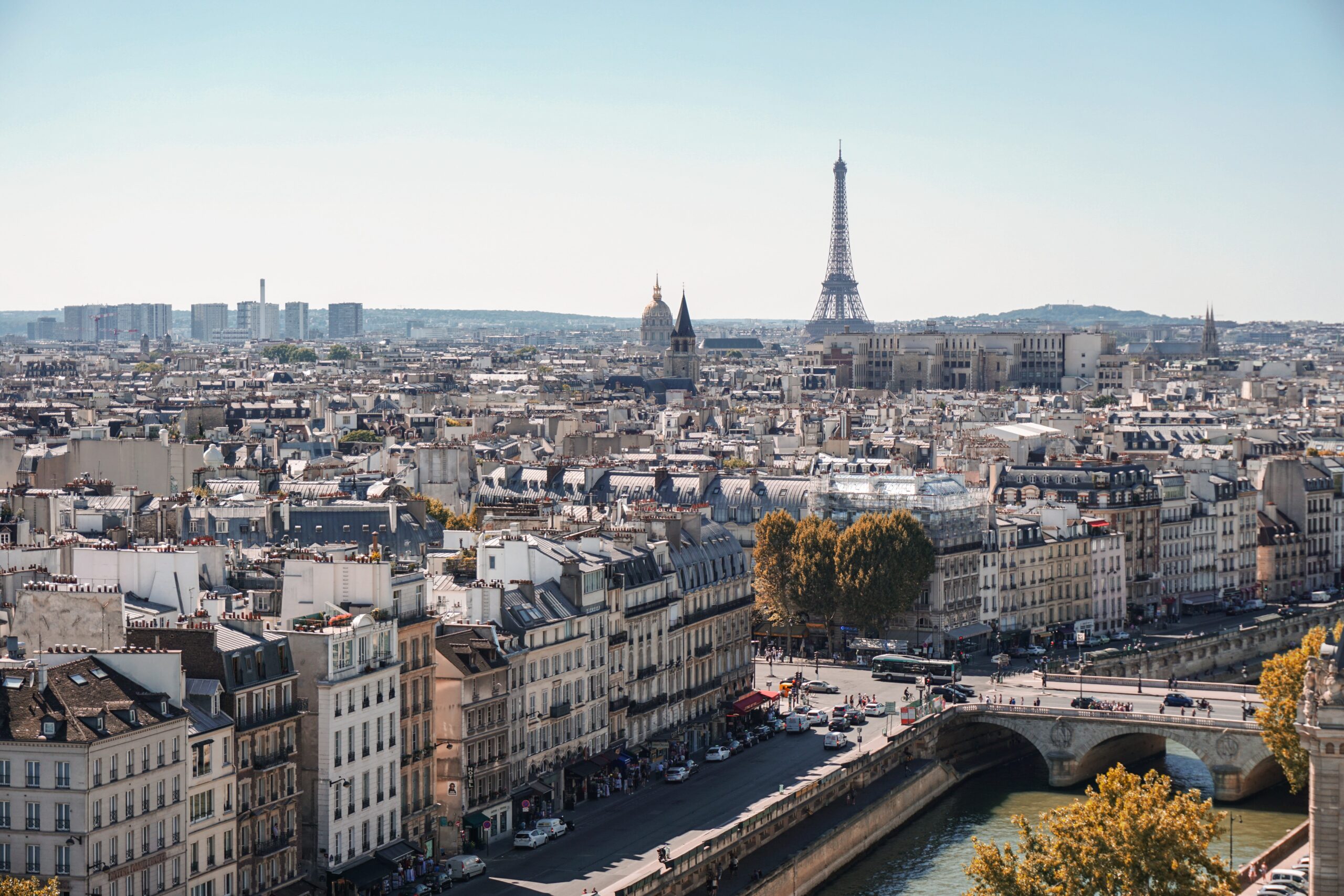
France Tourism Statistics and Analysis
- Post author By Giacomo Piva
- Post date April 17, 2024
It’s no secret that France is a popular tourist destination for travelers around the world. We’ve taken a look into the latest reports and studies to combine the top France tourism statistics for 2024.
Key statistics about tourism in France:
- Since 2010, France has received an average of 77.8 million international visitors each year, with 79.4 million in 2022.
- 2019 saw the highest number of international tourists in France, with 90.9 million people visiting the country.
- France is the most visited country in the world according to the U.N. with the USA coming in second.
- The most popular destination type for visitors to France was a city , with 29.3% of tourists choosing a city location for their trip.
- Disneyland Paris is the most visited attraction in France with 14.8 million yearly visitors.
- France’s travel and tourism market size is expected to reach $20.03 billion in 2024 , this is less than its European neighbors Spain ( $26.21 billion ) and Germany ($67.57 billion) .
- Hotels make up the largest proportion of France’s travel and tourism market , with a projected market volume of $10.69 billion in 2024 .
- In 2020, 134.6 million domestic tourists visited destinations in France, with 92.4% visiting for a leisure trip .
- Tourism accounts for 8% of France’s total GDP .
How many tourists visit France each year?
According to statistics from the U.N., France is the most visited country in the world with a peak of 90.9 visitors in 2019. This is followed by the USA with 79.3 million visitors in the same year. Between 2010 and 2022, France received an average of 77.8 million international overnight tourists per year.
Unsurprisingly, 2020 saw the lowest visitor numbers at 41.7 million due to travel restrictions during the COVID-19 pandemic. In 2022, tourism in France recovered with 79.4 million overnight visitors, a 64% increase compared to 2021’s 48.4 million overnight visitors.
Change in tourism to France over time
The number of international tourists visiting France maintained a steady increase between 2010 (77.6 million visitors) and 2019 (90.9 million visitors), with a slight drop in 2016 (82.7 million visitors).
Visitor numbers dropped by 54.1% in 2020 due to the pandemic. Since this drop in tourism in 2020, international visitor numbers to France recovered by 16.1% in 2021, when 48.4 million tourists visited the country. You can see in the graph what trend forecasting shows international arrivals would’ve looked like for France without the impact of the pandemic, with approximately 93.5 million in 2022.
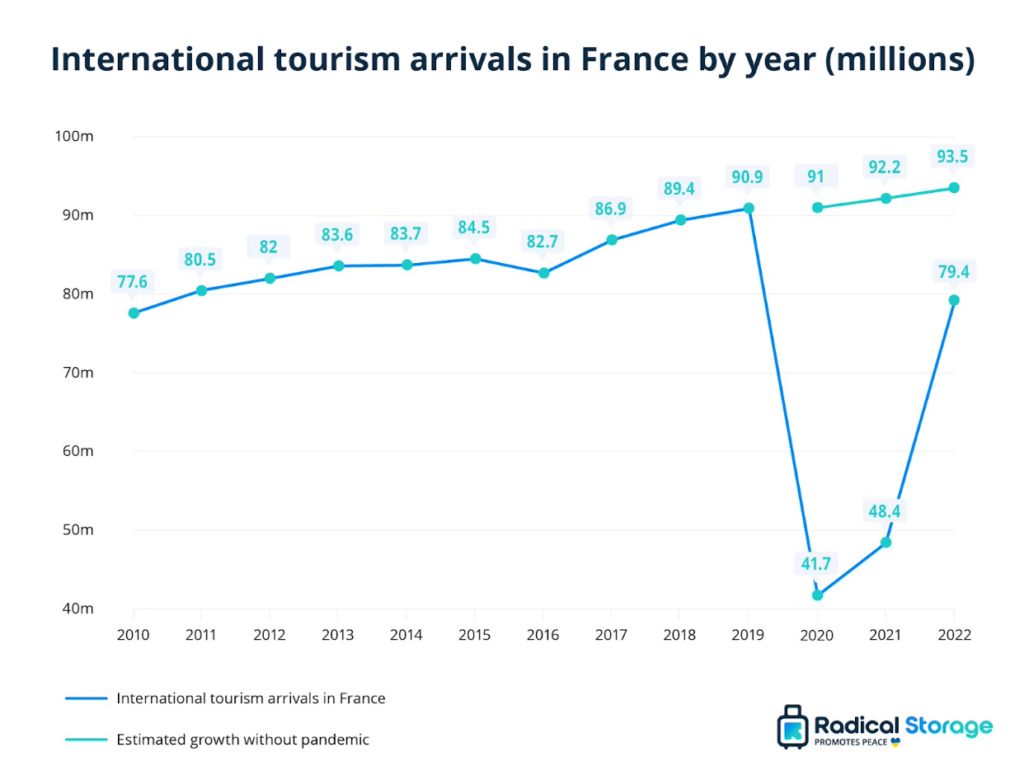
France tourism market size
In 2024, France’s travel and tourism market is expected to reach $20.03 billion. Revenue in this sector is predicted to have a CAGR of 0.86% between 2024 and 2028, with revenue reaching $20.73 billion in 2028.
Hotels take the largest segment of this market with a predicted volume of $10.69 billion in 2024, with hotels in France expecting to see 26.08 million users by 2028. Tourism is worth 8% of France’s GDP. [ 2 ]
Within France’s travel and tourism market, online sales are predicted to generate 77% of total revenue by 2028. [ 2 ]
France has spent 1.96 billion Euros on rejuvenating tourism in the country after COVID-19 which plans to create 2 million jobs in the industry. [ 3 ]
Most visited tourist attractions in France
France is home to a wide variety of cultural and recreational sites which attract millions of visitors each year. The most visited place by far in France is Disneyland Paris with 14.8 million visitors per year. This is followed by the Louvre Museum with 8 million visitors and Versailles Palace with 7.7 million visitors. The Eiffel Tower receives 6.2 million visitors per year.
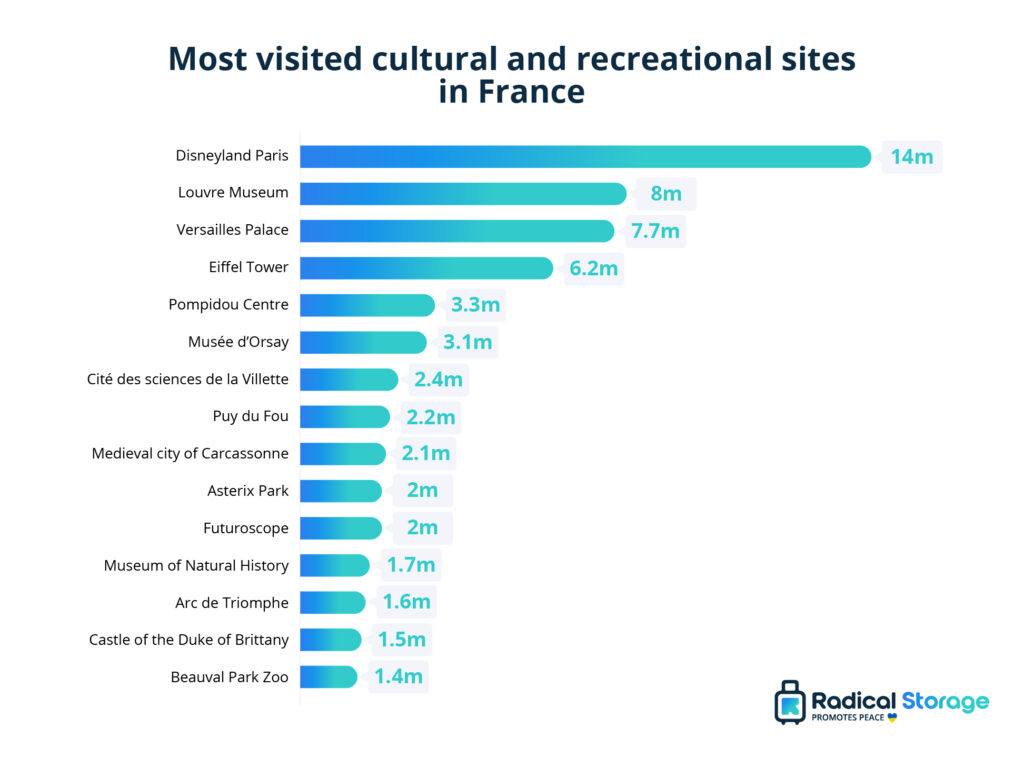
The most popular destinations for tourists in France
Using online search volumes for people searching from France, we have put together a list of the most popular tourist destinations for people living in France. The figures below are based on the average number of online searches per month for each attraction or destination.
Topping the list as the most popular attraction is Disneyland Paris, with an average monthly search volume of 450,000. The second most popular spot is Avignon with 144,000 monthly searches. Avignon is a city in France’s Provence region, once the seat of Catholic popes.
Other popular tourist attractions based on search volume include the tidal island Mont Saint Michel, the medieval citadel Carcassonne, and the port city of Le Havre in Normandy.
Trips by destination type
For those who visit France, there is a choice of destination types to choose from depending on the kind of trip you’d like to have. Of those who visited France in 2021, the most popular destination type was a city, with 28.3% choosing a city location. The next most popular was the seaside (21.1%), followed by the countryside (19.4%).
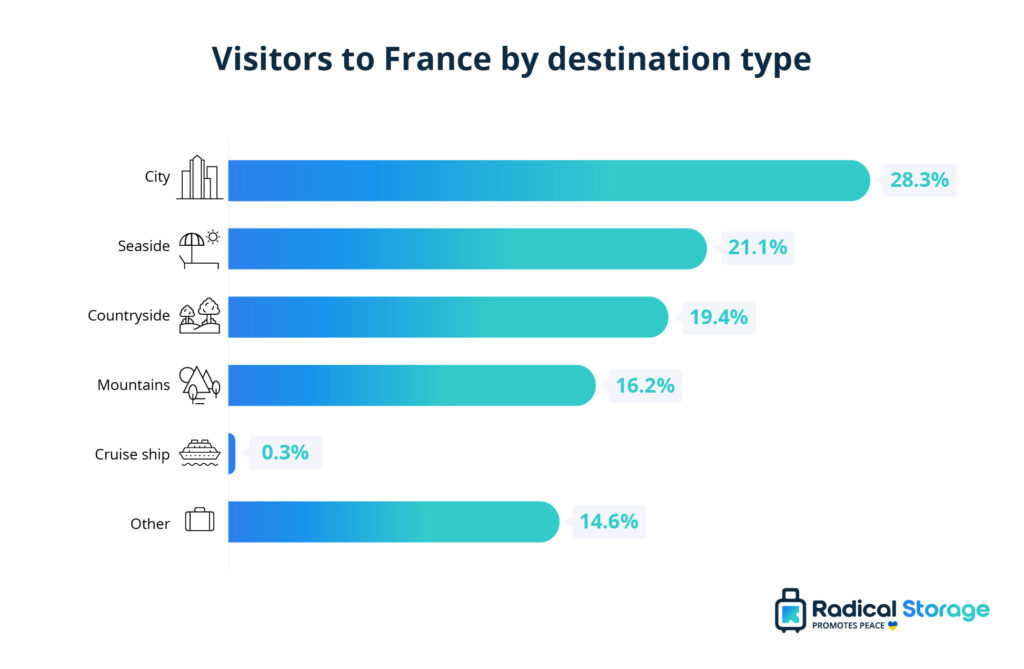
How long do people visit France for?
The number of nights an international visitor stays in France varies depending on a number of factors including where visitors are traveling from. The analysis below looks at international arrivals from the EU, the Americas, Asia, Africa, and Oceania.
People who travel from the EU are unsurprisingly the most likely to stay for only one night – also from the near London – with 17.2% of EU visitors staying in France for a night, however, the highest proportion of EU visitors (24.2%) stay for 4-6 days. Travelers from Africa are most likely to stay for longer periods with 57.1% staying in France for 7 days or more.

Domestic tourism statistics in France
Domestic tourism in France has followed a similar pattern to international tourism. Since 2012, domestic tourism expenditure has increased, peaking at €115.5 billion (EUR) in 2019, with a loss in 2020 to €58 billion. Since the pandemic, estimated figures show that domestic tourism expenditure in France recovered to €91.79 billion in 2021, with a slight drop to €89.2 billion in 2022.
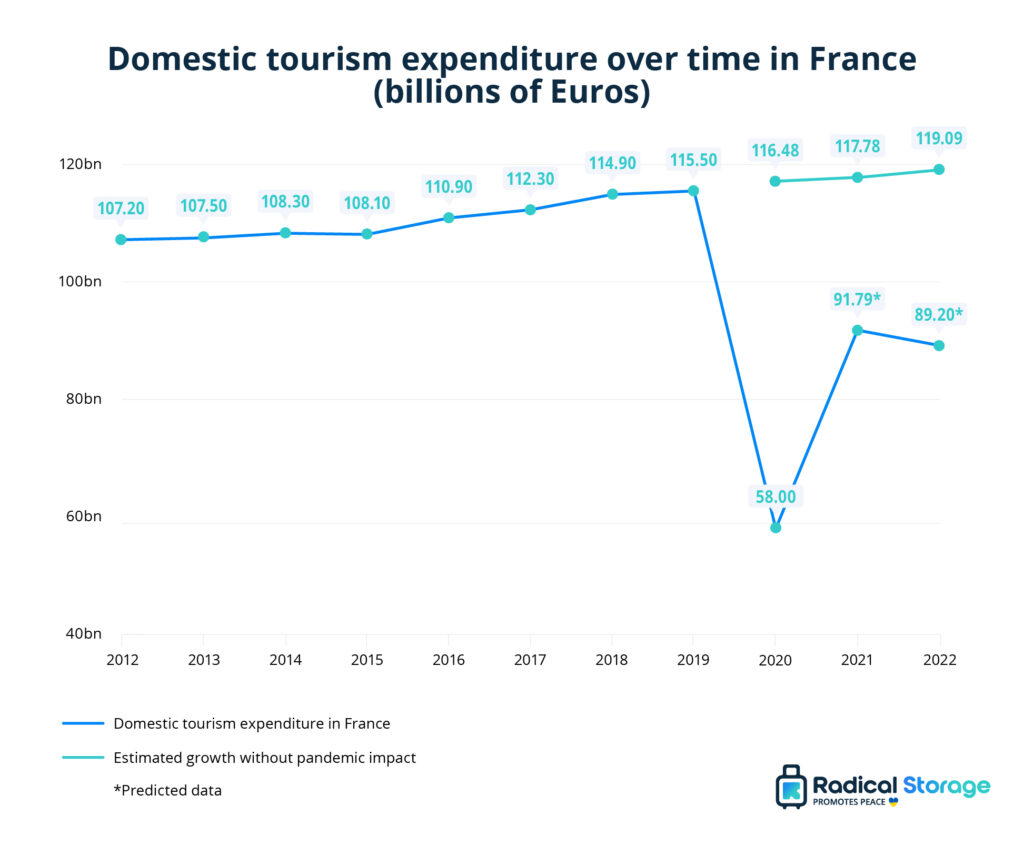
Of the 134.6 million domestic trips taken to destinations in France in 2020, 92.4% took leisure trips compared to 7.6% who took business trips. [ 8 ]
Tourist accommodation in France
The number of tourist accommodation options in France has remained fairly consistent since 2010. In 2021, there were 2.64 accommodation establishments, 101.2 rooms available, and 202.5 beds per 10,000 people in France.
Paris tourism statistics
As the capital city of France, Paris is also the most visited city in the world, with Paris and the Île-de-France region hosting 44 million tourists in 2022. [ 10 ] It offers a huge choice of attractions, cultural sites including street art and historic monument, and events for visitors to enjoy.
Where do visitors to Paris come from?
The countries that the most visitors to Paris come from are:
- Belgium (11%)
- United Kingdom (10%)
- United States (9%)
- Netherlands (8%)
- Germany (8%)
Accommodation tourists use in Paris
The majority of visitors to Paris (53%) stay at hotels when visiting for an overnight trip. 34% stay at non-market accommodations which includes Airbnb and other rentals, while the remaining 13% stay at other market accommodations such as apartments or hostels.
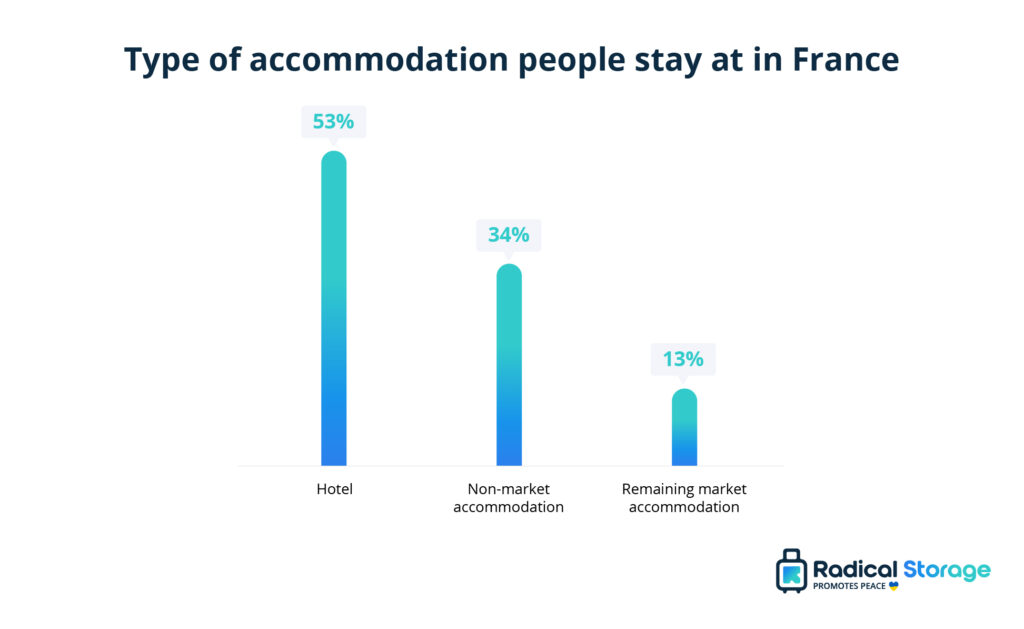
Average costs in Paris
On average, one person will spend €101 per day while staying in Paris . [ 11 ] The table below shows the average costs for food, drinks, and transport in Paris.
Did you know that Paris was ranked as the #1 destination for street food in 2022?
Most popular Parisian attractions by online mentions
There are several popular tourist attractions in Paris which see huge visitor numbers every year. The analysis below shows the popularity of tourist attractions in France based on mentions of each attraction in Twitter and Instagram posts.
The most popular attraction in Paris was the Eiffel Tower with 24.8% of the social media mentions, followed by the Louvre Museum with 11% of the mentions across all tourist attractions in Paris.
[1] UN: Global and regional tourism performance https://www.unwto.org/tourism-data/global-and-regional-tourism-performance
[2] Statista: Travel and Tourism France https://www.statista.com/outlook/mmo/travel-tourism/france
[3] French Government: Plan de reconquête et de transformation du tourisme https://www.diplomatie.gouv.fr/IMG/pdf/destinationfrance_cle0f5dc4.pdf
[4] Statista: Most Visited Tourism Attractions in France https://www.statista.com/statistics/1117144/most-visited-tourist-attractions-france/
[5] Eurostat: Trips by Destination Type https://ec.europa.eu/eurostat/databrowser/view/TOUR_DEM_TTHD/default/table?lang=en&category=tour.tour_dem.tour_dem_tt.tour_dem_tttc
[6] Memento de Tourisme: La Frequentation des Hebergements https://www.entreprises.gouv.fr/files/files/etudes-et-statistiques/chiffres-cles/memento-tourisme/memento-tourisme-2018-chapitre4.pdf
[7] Statista: Domestic Tourism Expenditure in France https://www.statista.com/statistics/644766/domestic-tourism-expenditure-france/
[8] Statista: Number of Domestic Trips by Type in France https://www.statista.com/statistics/1276815/domestic-trips-by-type-france/
[9] Macro Trends: France Population 1950- 2024 https://www.macrotrends.net/countries/FRA/france/population
[10] Brussels Times: Paris remains most visited city in the world https://www.brusselstimes.com/417329/paris-remains-most-visited-city-in-the-world-with-44-million-tourists-in-2022
[11] Visit Paris Region: Key Features of the Paris Region Destination https://pro.visitparisregion.com/en/tourism-statistics/annual-key-facts/key-figures-of-the-destination
[12] Numbeo: Cost of Living in France http://numbeo.com/
[13] Paris Digest: Tourism in Paris https://www.parisdigest.com/paris/tourism-in-paris-2019.pdf
By Giacomo Piva
Giacomo Piva, CMO and Co-founder at Radical Storage Giacomo Piva has worked in the travel industry since 2008 across multiple niches including tourist transportation, luxury travel, and ecotourism. He now focuses on growing the global luggage network, Radical Storage , which is currently available in over 500 cities, in the likes of London, Paris, New York, and Rio de Janeiro. Giacomo has a bachelor's degree in Communication Science and an in-depth experience across travel marketing, especially in improving a brand’s digital presence within the industry.
- Schengen Visa - Start Here
- Guides Comprehensive Step-By-Step Guides About the Schengen Visa Requirements & Application Process
- Statistics Get the latest and most up-to-date Schengen Visa and Europe tourism statistics
Home > Blog > Statistics > Latest France Travel Statistics & Data
Latest France Travel Statistics & Data
on 19 Oct, 2022
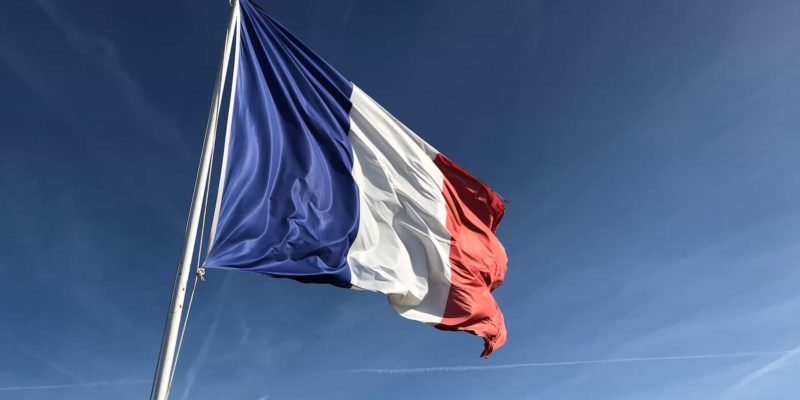
Last updated: October 19, 2022, by Grant Thomas
🔖Cite this webpage (Thomas, Grant. “Latest France Travel Statistics & Data”. visasassociation.com, October 19, 2022, https://visasassociation.com/statistics/france-travel-statistics )
Note : The latest statistics and travel data available about France are for 2021. We will update this page as soon as the 2022 Schengen Visa and tourism statistics on France are available.
Highlights : Latest France Tourism Statistics & Trends
- Over the past years, France has been the most popular destination country with the highest number of Schengen Visa applications .
- In 2021, France received 0.9% fewer Schengen Visa applications compared with 2020.
- In 2021, France’s Schengen Visa approval rate was 78.9% .
- In 2021, the occupancy of tourist accommodation establishments in France was a quarter lower compared with the pre-pandemic levels.
- During the first quarter of 2021, only a third of the rooms in hotels in Metropolitan France was occupied.
- In 2021, the Île-de-France region accounted for half of the tourism decline in France.
- In 2021, domestic and international tourists spent 141 billion euros in Metropolitan France.
- In 2021, the Paris region recorded 22.6 million domestic and international visitors, an increase of 30% compared to 2020.
- In 2021, the contribution of the travel and tourism sector to the GDP in France increased by 33% compared to 2020, reaching 161.5 billion euros.
- In 2021, Algeria submitted over 88,500 ( 13.6% ) Schengen Visa applications for France.
- In 2021, the countries with the highest France Schengen Visa rejection rate were Iraq ( 48.2% ) and Angola ( 44.9% ).
- In 2021, France recorded the highest number of overnight stays spent by resident visitors in July since 2011 ( 14.8 million ).
Tourism recovering in France, but not back to pre-pandemic levels
In 2020, the COVID-19 pandemic outbreak dramatically affected the tourism sector in France, with the contribution of the travel and tourism sector falling to just 108 billion euros from 211 billion euros in 2019.
With the gradual lifting of travel restrictions in 2021, a rise in the number of nights spent by residents has provided some relief to the country.
According to the National Institute of Statistics and Economic Studies (INSEE) , the recovery of the tourism sector was more significant on the coast and in the mountains than in large urban zones.
However, the numbers achieved in 2021 were not enough to reach the pre-pandemic 2019 levels.
This is because the return to non-resident visitors remained flat in 2021, especially in the Île-de-France region where arrivals of non-residents were at 21% of their summer pre-pandemic levels.
In addition, employment remained stagnant in 2021, after suffering a loss of nearly 200,000 jobs due to restrictions on travel and daily life.
- In 2021, France received 652,331 Schengen Visa applications, -0.9% compared with 2020.
- In 2021, France received 84% fewer Schengen Visa applications compared with 2019.
- France issued 480,057 Schengen Visas in 2021, 13% or 72,336 fewer than in 2020.
- In 2021, France recorded 961.3 million overnight stays, an increment of 12% compared to 2020.
- During the first quarter of 2021, the Île-de-France region recorded a drop of 81% in hotel occupancy compared with the same period in 2019.
- In the first quarter of 2021, hotel overnight stays in France recorded a drop of 63.7% compared with the same period in 2019.
- In the second quarter of 2021, hotel occupancy was 39% of the pre-pandemic levels.
- In the second quarter of 2021, hotel overnight stays in France recorded a drop of 60.9% compared with the same period in 2019.
- In the third quarter of 2021, hotel overnight stays in France recorded a drop of 18% compared with the same period in 2019.
- In the fourth quarter of 2021, hotel overnight stays in France recorded a drop of 12.4% compared with the same period in 2019.
- During the fourth quarter of 2021, France recorded a drop of 42% in overnight stays from the United Kingdom compared with the same period in 2019.
- In August 2021, the number of nights spent at hotels by non-resident tourists in Metropolitan France increased by 35% over the same period in 2020.
- In August 2021, the number of arrivals at hotels in Metropolitan France increased by 11% over the same period in 2020.
- In August 2021, France recorded approximately the same number of arrivals of resident tourists at hotels in Metropolitan France as in August 2020 ( 8,600 and 8,200 , respectively).
- In August 2021, the occupancy rate in hotels in Paris was 49.8% , with 18.7 percentage points higher than in August 2020.
- In 2021, 3-star hotels were the most popular among visitors of Metropolitan France.
- In 2021, France recorded 25,800 overnight stays in 1 and 2-star hotels, a very slight increase compared with 2020 ( 0.39% ).
- In 2021, France recorded 47,300 overnight stays in 3-star hotels, an increase of 13% compared with 2020.
- In 2021, France recorded 30,915 overnight stays in 4 and 5-star hotels, an increase of 20% compared with 2020.
- In August 2021, the hotel occupancy rate in France was 63.4 , showing an increase of 3.9 percentage points compared with the same period in 2020.
- In October 2021, France recorded 51.3% fewer international visitors compared with the same period in 2019.
- In October 2021, France recorded 56.9% fewer business visitors compared with the same period in 2019.
- Between 2019 and 2021, the average length of stay in hotels in France was 1.8 days.
- In 2021, France recorded 118,195 overnight stays in hotels, an increase of 10% compared to 2020.
- In October 2021, the international arrivals in Metropolitan France from Western Europe dropped by 37.2% compared to the same period in 2019.
International Arrivals in Metropolitan France in October 2021 Compared with October 2019 (%)
- In 2021, France ranked no.1 for the number of Schengen Visa applications received.
- In July 2021, domestic and international visitors spent 18.9 million overnight stays in hotels in France which represents 81% of the pre-pandemic level.
- In July 2021, resident tourists spent 14.8 million overnight stays in hotels in France.
- In July 2021, international tourists from EU countries spent 3.5 million overnight stays in hotels in France.
- In July 2021, tourists from countries outside the EU spent 0.6 million overnight stays in hotels in France.
- In 2021, France recorded 66,520 arrivals in hotels, an increase of 10% compared with 2020.
- In 2021, France recorded 66,520 arrivals in hotels, a drop of 52% compared with 2019.
- In 2021, France recorded 18.4 million trips for professional purposes, an increase of 11% compared to 2020.
- In 2021, France recorded 181.8 million trips for professional purposes, an increase of 18% compared to 2020.
France: Latest Schengen Visa Applications and Tourism Trends
France’s schengen visa approval rate from 2015 to 2021, countries that submitted the highest number of schengen visa applications for france from 2015 to 2021, contribution of travel and tourism to gdp in france from 2015 to 2021, top 5 countries that submitted the highest number of schengen visa applications for france in 2021, approval rates for the countries that submitted the highest number of schengen visa applications for france in 2021, top 5 third countries that had the highest rejection rates for the schengen visa for france in 2021, total overnight stays in hotels in france from 2015 to 2021, total number of arrivals in hotels in france from 2015 to 2021, total overnight stays in 1 and 2-star hotels in france from 2015 to 2021, total overnight stays in 3-star hotels in france from 2015 to 2021, total overnight stays in 4 and 5-star hotels in france from 2015 to 2021, sources: .
European Commission – Statistics on short-stay visas issued by the Schengen States
EUROSTAT – Tourism Statistics
INSEE – National Institute of Statistics and Economic Studies
Atout France – Note de conjoncture de l’économie touristique
Confused Where To Start?
If you are confused, worried or stuck, the best next step to take is to Get a Free Consultation .
The session takes 5 to 10 minutes, starts immediately and you will get our advice delivered to your inbox by a Visa Expert within 1-2 hours. This is not a video or phone call, it is just like a live chat, where we can understand your situation better and an expert shares what you should do next.
There is no commitment to use our services at all, we just provide you advice based on our assessment of your situation and give you the next steps you need to follow to get your Schengen visa.
Click the Free Consultation button below to get the information you have been searching for
Visas Assoc.
Schengen visa.
- Free Consultation
- Personal Plan
Customer Care
- Privacy Policy
- Terms and Conditions
- Search Please fill out this field.
- Manage Your Subscription
- Give a Gift Subscription
- Sweepstakes
Paris Is Going to Be More Expensive for Travelers in 2024 — Here's Why
Paris' tourism tax increase was implemented on Jan. 1.
:max_bytes(150000):strip_icc():format(webp)/alison-fox-author-pic-15f25761041b477aaf424ceca6618580.jpg)
Alexander Spatari/Getty Images
Visiting Paris is about to get a bit more expensive as the city raised taxes on hotels and other accommodations at the beginning of the year.
The increase, which went into effect on Jan. 1, charges travelers up to nearly 200 percent more in nightly tax to stay in 2024, Atout France, the country’s tourism development agency confirmed to Travel + Leisure. The tax increase varies based on the type of accommodation.
The largest increase is for travelers staying in “palaces.” Those tourists will have to pay a nightly tax of €14.95 ($16.38), a 199 percent increase compared to the 2023 rate of €5 ($5.48). Travelers in 5-star accommodations will have to pay a nightly rate of €10.73 ($11.75), a 186 percent increase compared to the 2023 rate of €3.75 ($4.11), and travelers in 4-star hotels will have to pay a new rate of €8.13 ($8.91), a 182 percent increase compared to the 2023 rate of €2.88 ($3.15).
Travelers staying in 1-star hotels, holiday villages, guest rooms, or hostels will have a more modest increase with the new rate of €2.60 ($2.85), compared to the 2023 rate of €1 ($1.10).
The decision to raise taxes comes months ahead of the much-anticipated Paris Olympics . Hotel prices have been on the rise leading up to the games, averaging more than 300 percent higher than normal for this summer. Overall, Paris expects more than 11 million visitors to head to the city for the event, which kicks off July 26.
Paris is also not alone in raising taxes. Amsterdam similarly approved a city tourist tax increase for this year, requiring visitors to pay 12.5 percent. The tax will apply to both travelers staying overnight and visiting on cruise ships.
Some destinations are adding new taxes for travelers, like Iceland, which will start charging travelers in an effort to support the country’s climate and sustainability goals, and Venice, which plans to implement a fee for day trippers this spring in addition to the tax it already charges overnight guests.

Tourism in France: A Comprehensive Overview
Disclaimer: Some posts on Tourism Teacher may contain affiliate links. If you appreciate this content, you can show your support by making a purchase through these links or by buying me a coffee . Thank you for your support!
Tourism in France is a huge industry. But why is tourism in France so important and why does it bring in so much money? Read on to find out all about tourism in France…
Overview of France
The tourism industry in france, why people travel to france, most popular types of tourism in france, most popular tourist attractions in france, what types of tourists travel to france, crime and safety in france, required budget to visit france, tourism in france: general tips for visiting, 10 interesting facts about france, faqs about tourism in france, tourism in france: to conclude, tourism in france .
Tourism in France is one of the most important industries that the country has. But what is tourism in France all about? Why do people travel here and what do they do during their visits? Lets take a deeper look at tourism in France…
Part of the success of tourism in France is attributed to its accessible location. France is a country located in Western Europe. It is the largest country in the European Union , covering an area of approximately 643,801 square kilometres. France shares its borders with Belgium, Luxembourg, Germany, Switzerland , Italy, Spain, and Andorra. The country also has coastlines along the English Channel, the Atlantic Ocean , and the Mediterranean Sea.

France has a diverse geography , with several mountain ranges, rivers, and plains. The Alps mountain range is located in the southeastern part of the country and includes Mont Blanc, the highest mountain in Western Europe. The Pyrenees mountain range forms the border between France and Spain in the south.
The Massif Central is a mountain range located in the centre of the country, and the Vosges and Jura mountain ranges are in the northeast. France also has several large rivers, including the Seine, Loire, Garonne, and Rhone. The country’s largest lake is Lake Geneva, which is shared with Switzerland.
The French coastline is approximately 3,427 kilometres long and includes several famous beaches and seaside resorts, such as Nice, Cannes, and Saint-Tropez on the French Riviera. The country also has several islands , including Corsica, which is located in the Mediterranean Sea.
France has a varied climate, with mild winters and hot summers in the south, while the north experiences cooler temperatures and frequent rainfall. The country is also known for its diverse wildlife and is home to several national parks and nature reserves, including the Vanoise National Park, the Pyrenees National Park, and the Mercantour National Park.

France is one of the most popular tourist destinations in the world , and tourism in France is a major contributor to the country’s economy. Here are some statistics about tourism in France:
- In 2019, France welcomed over 90 million international visitors, making it the most visited country in the world.
- The tourism industry in France generated over 60 billion euros in revenue in 2019.
- The country has over 500,000 hotel rooms and more than 40,000 campsites, making it one of the largest hospitality industries in Europe.
- Paris is the most popular tourist destination in France, with over 33 million visitors in 2019. Other popular destinations include the French Riviera, the Loire Valley, and the wine regions of Bordeaux and Burgundy.
- The tourism industry in France employs over 2 million people, making it one of the largest employers in the country.
- Chinese tourists are the largest group of international visitors to France, followed by visitors from the United States, Germany, and the United Kingdom.
- In 2020, the COVID-19 pandemic had a significant impact on the tourism industry in France, with international arrivals dropping by 70% compared to the previous year.
- France has a well-developed transport infrastructure, including high-speed trains, an extensive network of airports, and a large fleet of rental cars. The country is also popular for river cruises and cycling holidays.
- France is known for its cultural attractions, including museums, galleries, and historic landmarks such as the Eiffel Tower, the Palace of Versailles, and the Mont-Saint-Michel.
- The country is also famous for its gastronomy, with French cuisine recognized as a UNESCO Intangible Cultural Heritage. Visitors to France can enjoy a wide range of culinary experiences, including Michelin-starred restaurants, local markets, and wine tastings.

Tourism in France is popular for many reasons, including its rich culture , history, and natural beauty. Here are some of the main reasons why people travel to France:

- Culture and History: France is renowned for its culture and history, including its art, architecture, and museums. Visitors can explore famous landmarks such as the Eiffel Tower, Notre-Dame Cathedral, and the Palace of Versailles. France is also home to some of the world’s most famous museums, including the Louvre, the Musée d’Orsay, and the Pompidou Center.
- Food and Wine : French cuisine is famous around the world, and visitors can enjoy a wide variety of dishes, from croissants and baguettes to coq au vin and bouillabaisse. Tourism in France is also known for its excellent wine drinking opportunities, with many famous wine regions such as Bordeaux, Champagne, and Burgundy.
- Fashion and Shopping: France is a world leader in fashion, and visitors can explore high-end designer boutiques, as well as more affordable fashion outlets. Paris, in particular, is known for its fashion shows, designer shops, and iconic department stores such as Galeries Lafayette and Printemps.
- Natural Beauty: France has a diverse landscape, including mountains, forests , beaches, and vineyards. Visitors can explore stunning natural landmarks such as Mont Blanc, the French Alps, the lavender fields of Provence, and the beaches of the French Riviera.
- Language and Culture Immersion: French is one of the world’s most widely spoken languages, and visitors can immerse themselves in French culture by learning the language, experiencing the local customs and traditions, and staying with local families.
Tourism in France is known for having various types of tourism . Here are some of the most popular types of tourism in France:
- Cultural tourism : France is famous for its rich cultural heritage, including its museums, art galleries, and historic landmarks. Popular cultural attractions include the Louvre Museum in Paris, the Palace of Versailles, and the Roman amphitheater in Nimes.
- Gastronomic tourism : French cuisine is known worldwide, and France is home to some of the world’s most famous restaurants, including Michelin-starred establishments. Visitors can also explore local markets and food festivals to discover regional specialties.
- Wine tourism : France is one of the world’s largest wine producers and is home to many famous wine regions, including Bordeaux, Burgundy, and Champagne. Wine lovers can visit vineyards and cellars for tastings and tours.
- Beach tourism: France has a long coastline along the Atlantic Ocean, the English Channel, and the Mediterranean Sea. Popular beach destinations include the French Riviera, Biarritz, and Saint-Malo.
- Nature tourism : France has a diverse landscape, including mountains, forests, and rivers. Popular outdoor activities include hiking, skiing, kayaking, and cycling.
- Historical tourism: France has a rich history, and visitors can explore its many historic sites, including castles, cathedrals, and medieval towns.
- City tourism: Paris is the most popular city destination in France, attracting millions of visitors each year. Other popular cities include Lyon, Marseille, and Toulouse.
- Luxury tourism: France is renowned for its luxury goods and services, including fashion, perfumes, and hotels. Visitors can enjoy five-star accommodations, designer shopping, and exclusive experiences.
- Shopping tourism: France has some great shopping opportunities, especially during winter when the French Christmas markets are in full swing!
France has many famous tourist attractions that are popular with visitors from all over the world. Here are some of the most popular tourist attractions in France:
- Eiffel Tower : The Eiffel Tower is one of the most iconic landmarks in the world and is a must-visit attraction for anyone traveling to Paris. Visitors can climb to the top of the tower for stunning views of the city.
- Louvre Museum : The Louvre is one of the largest and most famous museums in the world, and is home to thousands of artworks, including the Mona Lisa and the Venus de Milo.
- Palace of Versailles: The Palace of Versailles was once the residence of the French kings and is now a UNESCO World Heritage site. Visitors can explore the palace’s opulent rooms and gardens.
- Notre-Dame Cathedral: Notre-Dame Cathedral is one of the most famous cathedrals in the world and is a masterpiece of Gothic architecture.
- Mont Saint-Michel : Mont Saint-Michel is a medieval abbey located on an island off the coast of Normandy. It is a UNESCO World Heritage site and is famous for its stunning architecture and scenic views.
- French Riviera : The French Riviera is a popular destination for beachgoers and is home to many famous towns and cities, including Cannes, Nice, and Saint-Tropez.
- Arc de Triomphe: The Arc de Triomphe is a famous monument located at the end of the Champs-Élysées in Paris. It was built to honor those who fought and died for France in the French Revolutionary and Napoleonic Wars.
- Château de Chambord: Château de Chambord is a Renaissance castle located in the Loire Valley. It is famous for its stunning architecture and extensive gardens.
- Pont du Gard: The Pont du Gard is a Roman aqueduct located in the south of France. It is a UNESCO World Heritage site and is famous for its impressive engineering.
- Normandy D-Day Beaches: The Normandy D-Day beaches are a popular destination for history buffs and are famous for the role they played in the Allied invasion of Normandy during World War II.

Tourism in France attracts a diverse range of tourists from all over the world. Here are some of the main types of tourists who travel to France:
- Culture and History Tourists: France has a rich cultural heritage and a long history, and many tourists travel to France to explore its museums, art galleries, and historic landmarks.
- Food and Wine Tourists: French cuisine is famous around the world, and many tourists travel to France to sample its delicious food and wine. France has many famous wine regions, such as Bordeaux and Burgundy, and visitors can enjoy wine tasting tours and vineyard visits.
- Fashion and Shopping Tourists: France is a world leader in fashion, and many tourists travel to France to shop in its high-end designer boutiques and department stores. Paris, in particular, is known for its fashion shows and designer shops.
- Natural Beauty Tourists: France has a diverse landscape, including mountains, forests, beaches, and vineyards, and many tourists travel to France to explore its stunning natural landmarks, such as the French Alps, the lavender fields of Provence, and the beaches of the French Riviera.
- Language and Culture Immersion Tourists: French is one of the world’s most widely spoken languages, and many tourists travel to France to immerse themselves in French culture, learn the language, and experience the local customs and traditions.
France is generally a safe country for tourists, but like any country, there are certain areas or situations where travellers may face risks. Here is some information about crime and safety when considering tourism in France:
- Petty crime : Theft, pickpocketing, and purse-snatching are common in tourist areas, especially in large cities like Paris. Tourists should be aware of their surroundings, avoid carrying large sums of cash or valuable items, and keep their belongings close to them
- Scams : Tourists may also encounter scams, particularly around popular tourist attractions. Examples include people offering to take pictures for money, people pretending to be deaf or mute and asking for donations, or individuals trying to sell fake souvenirs.
- Terrorism : France has experienced several high-profile terrorist attacks in recent years, including the 2015 Paris attacks. While security measures have been increased since then, visitors should remain vigilant and aware of their surroundings, especially in crowded areas.
- Demonstrations : Demonstrations and protests are common in France and can turn violent. Visitors should avoid areas where demonstrations are taking place and follow the advice of local authorities.
- Public transportation: Public transportation in France is generally safe, but visitors should be aware of their surroundings and take precautions, such as keeping their belongings close and being aware of pickpockets.
- Driving : Driving in France can be challenging, especially in large cities like Paris. Visitors should be aware of local driving laws and regulations, and consider hiring a local driver or using public transportation instead.
- Natural disasters : France is prone to natural disasters, including floods, wildfires, and earthquakes. Visitors should check weather reports and follow the advice of local authorities during such events.
Visitors to France should exercise common sense and take precautions to ensure their safety. It is recommended to stay aware of their surroundings and avoid areas where crime is known to be prevalent. Additionally, keeping important documents and valuables in a safe place and not carrying too much cash is also recommended.
The required budget to visit France will depend on various factors, such as the duration of the trip, the cities and attractions you plan to visit, and your travel style. Here are some estimated costs to give you an idea of what to expect:
Accommodation
The cost of accommodation in France varies widely depending on the city and type of accommodation. Budget hotels or hostels can cost around £30-50 per night, while mid-range hotels can cost £80-120 per night. Luxury hotels can cost £200 or more per night.
French cuisine is world-renowned, but dining out in France can be expensive. A meal in a budget restaurant can cost around £15-25, while a mid-range restaurant can cost £30-50 per person. Fine dining can cost £100 or more per person. To save money, visitors can consider purchasing food from local markets and grocery stores.
Transportation
Public transportation in France is relatively affordable. A single metro or bus ticket in Paris costs £1.90, while a one-way train ticket between cities can cost £20-50 depending on the distance. Taxis can be expensive, with a starting rate of around £2.50 plus £1.10 per kilometer.
Attractions
Admission fees to popular attractions in France vary widely. For example, the Louvre Museum in Paris costs £15 for adults, while admission to the Palace of Versailles costs £18. Some museums offer free admission on the first Sunday of the month.
Miscellaneous expenses
Other expenses to consider include travel insurance, visas (if applicable), and souvenirs.

Here are some general tips for visiting France:
- Learn some basic French : While many French people speak English, learning a few basic French phrases can go a long way in making a good impression and communicating with locals.
- Dress appropriately: French people tend to dress stylishly, so it’s a good idea to dress up a bit, especially when visiting religious sites or fine dining restaurants. Additionally, be sure to check the dress code for any attractions you plan to visit.
- Follow dining etiquette : When dining out, it’s customary to wait to be seated, use proper cutlery, and keep your hands on the table. Additionally, it’s considered rude to ask for separate checks, so be prepared to split the bill.
- Be aware of business hours: Many shops and businesses in France close for several hours during the afternoon, especially in smaller towns. Additionally, many shops and businesses are closed on Sundays.
- Be aware of public holidays: Many attractions, shops, and businesses in France close during public holidays, so it’s important to plan accordingly.
- Use public transportation: Public transportation in France is generally safe, affordable, and efficient. Consider using the metro, bus, or train to get around, especially in larger cities.
- Be aware of pickpockets : Pickpocketing is a common problem in tourist areas in France, especially in larger cities like Paris. Be aware of your surroundings, keep your belongings close, and avoid carrying large sums of cash.
- Respect cultural norms : French culture places a strong emphasis on politeness and courtesy. Be sure to say “Bonjour” when entering a shop or restaurant, wait to be seated, and avoid speaking too loudly or aggressively.
- Plan ahead: Many popular attractions in France, such as the Eiffel Tower or the Louvre, require advanced booking. Be sure to plan ahead and book tickets in advance to avoid long lines or disappointment.
- Enjoy the local cuisine: French cuisine is world-renowned, so be sure to try some local specialties during your visit. Don’t be afraid to try new dishes or ask for recommendations from locals.
Here are 10 interesting facts about France:
- France is the largest country in the European Union, covering an area of 643,801 square kilometers.
- The Eiffel Tower in Paris, one of France’s most iconic landmarks, was originally built as a temporary structure for the 1889 World’s Fair.
- French is the official language of France, and it is also spoken in many other countries around the world, including Canada, Switzerland, and parts of Africa.
- The Louvre Museum in Paris is the world’s largest art museum, with over 380,000 objects in its collection.
- France is famous for its wine, and it is the second-largest wine-producing country in the world after Italy.
- French cuisine is renowned around the world for its sophistication and variety, with dishes like escargots, foie gras, and macarons.
- French fashion is also famous, with designers like Coco Chanel, Christian Dior, and Yves Saint Laurent making their mark on the industry.
- French mathematician Blaise Pascal invented the first mechanical calculator in 1642.
- The Palace of Versailles, located just outside Paris, was the residence of the French monarchy from 1682 until the French Revolution in 1789.
- The French celebrate Bastille Day on July 14th every year, commemorating the storming of the Bastille prison during the French Revolution in 1789. It is a national holiday and is celebrated with parades, fireworks, and other festivities.

Lets finish off this article by answering some of the most common questions about tourism in France. Here are 10 frequently asked questions about tourism in France:
- What is the best time of year to visit France?
The best time to visit France depends on your preferences. Summer (June to August) is the peak tourist season, with warm weather and many festivals and events. Spring (March to May) and fall (September to November) are also popular times to visit, with milder weather and fewer crowds.
- Do I need a visa to visit France?
Citizens from many countries, including the US, Canada, and Australia , can visit France for up to 90 days without a visa. Check with your local embassy or consulate to see if you need a visa for your trip.
- What is the currency used in France?
The official currency of France is the euro (€).
- What is the best way to get around France?
France has a well-developed transportation network, including trains, buses, and domestic flights. The most popular way to get around is by train, with the SNCF offering high-speed trains between major cities.
- What are the must-see attractions in France?
France is home to many iconic attractions, including the Eiffel Tower, the Louvre Museum, the Palace of Versailles, Notre Dame Cathedral, and the French Riviera.
- What is the drinking age in France?
The legal drinking age in France is 18.
- What is the tipping etiquette in France?
Tipping in France is not mandatory, but it is appreciated. A service charge is often included in the bill, but it’s customary to leave an additional 5-10% tip for good service.
- Is it safe to travel to France?
France is generally a safe country to visit, but tourists should be aware of pickpocketing and other petty crime in tourist areas. It’s also a good idea to be vigilant and aware of your surroundings.
- What is the food like in France?
French cuisine is world-renowned, with a focus on fresh, high-quality ingredients and classic techniques. Popular dishes include croissants, baguettes, cheese, wine, escargots, and steak frites.
- What is the official language of France?
The official language of France is French, but many people in tourist areas also speak English.
As you can see, tourism in France is a large industry, that yields significant economic benefits for the country. There are a number of reasons that tourism in France is such big business, from the range of tourist attractions to the different types of activities on offer.
If you enjoyed this article about tourism in France, I am sure you will enjoy these too:
- What is France famous for?
- 40 Fascinating facts The 17 Most Impressive Rivers in France
- 35 fascinating facts about France
- 21 Mesmerising Landmarks of France
Liked this article? Click to share!
Winter is here! Check out the winter wonderlands at these 5 amazing winter destinations in Montana
- Travel Destinations
How Much Does France Make From Tourism
Published: December 12, 2023
Modified: December 28, 2023
by Doti Cobbs
- Hotel Reviews
- Plan Your Trip
- Travel Guide
Introduction
Welcome to the enchanting world of French tourism. From the picturesque streets of Paris to the sun-soaked beaches of the French Riviera, France has long been a top destination for travelers around the world. But have you ever wondered just how much money France makes from tourism? In this article, we will delve into the depth of France’s tourism industry, explore the revenue generated from tourist arrivals, and uncover the impact of tourism on the country’s economy.
France is renowned for its rich history, diverse culture, and stunning landscapes, making it a magnet for tourists. Whether it’s visiting iconic landmarks like the Eiffel Tower and the Louvre Museum in Paris, exploring the vineyards of Bordeaux, or basking in the charm of the French countryside, there is something to captivate every traveler’s imagination.
France’s tourism industry has witnessed steady growth over the years, attracting millions of visitors from all corners of the globe. These tourists not only contribute to the country’s economy but also support local businesses, create jobs, and promote cultural exchange.
So, just how much does France make from tourism? Let’s dive into the numbers and explore the economic significance of this thriving industry.
Overview of France’s Tourism Industry
France’s tourism industry is one of the largest in the world, attracting over 89 million international tourists in 2019 alone. It is known for its remarkable versatility, offering a wide range of experiences to suit every traveler’s interests.
One of the key factors driving France’s tourism industry is its geographical diversity. From the snow-capped peaks of the French Alps, to the charming villages of Provence, and the sandy beaches of the French Riviera, the country’s landscape offers a variety of experiences for nature lovers, adventure seekers, and beach enthusiasts alike.
Additionally, France’s rich history and cultural heritage are major draws for tourists. The country is home to numerous UNESCO World Heritage sites, iconic landmarks such as the Eiffel Tower, Notre-Dame Cathedral, and the Palace of Versailles, as well as world-class museums like the Louvre and the Musée d’Orsay.
Furthermore, France is synonymous with culinary excellence and has a reputation for its gastronomy. French cuisine, with its exquisite flavors and techniques, is a major attraction for food enthusiasts. The country’s wine regions, such as Bordeaux and Burgundy, also draw wine connoisseurs from around the world.
Notably, France has established a well-developed tourism infrastructure with a wide range of accommodation options, transportation networks, and tourist services. This infrastructure helps ensure a smooth and comfortable experience for visitors, further enhancing the appeal of the country as a tourist destination.
Overall, France’s tourism industry caters to a diverse range of interests, making it a sought-after destination for travelers of all kinds. Its unique blend of history, culture, natural beauty, and culinary delights have positioned it as a top choice among tourists worldwide.
Revenue Generated from Tourist Arrivals
The tourism industry plays a significant role in France’s economy, contributing a substantial amount of revenue. In 2019, the total tourism revenue reached a staggering €56.1 billion, accounting for 7.4% of the country’s GDP. This revenue is generated from various sources, including accommodations, transportation, food and beverages, entertainment, and retail.
Accommodation is a major source of revenue in the tourism sector. France offers a wide range of options, from luxury hotels in major cities to charming bed and breakfasts in the countryside. The revenue generated from accommodations alone amounts to several billion euros annually.
Transportation is another significant revenue generator. Tourists often rely on planes, trains, and buses to travel within the country. France’s extensive transportation network, including high-speed trains and well-connected airports, ensures convenient access to different regions, boosting tourism revenue.
Food and beverages also contribute to France’s tourism revenue as visitors indulge in the country’s world-renowned cuisine. Whether it’s dining at Michelin-starred restaurants, sampling local delicacies from street markets, or sipping wines from prestigious vineyards, tourists’ gastronomic experiences generate substantial income for the country.
Entertainment and attractions are key contributors to tourism revenue as well. From iconic landmarks like the Eiffel Tower and the Mont Saint-Michel to theme parks like Disneyland Paris, these attractions draw millions of visitors each year, generating significant income through ticket sales and related expenditures.
Shopping is another aspect of tourism revenue that should not be overlooked. France is synonymous with fashion, and Paris, in particular, is a fashion capital of the world. Tourists flock to luxury boutiques, department stores, and designer outlets, contributing to the retail sector’s revenue.
Overall, the revenue generated from tourist arrivals in France is multi-faceted, with accommodations, transportation, food and beverages, entertainment, and retail sectors all playing vital roles. This revenue not only supports the tourism industry but also has a ripple effect on other sectors of the economy, creating jobs and generating additional income.
Contribution of Tourism to France’s GDP
Tourism is a significant contributor to France’s Gross Domestic Product (GDP), playing a vital role in the country’s economy. In 2019, tourism directly contributed €170 billion to France’s GDP, accounting for 7.4% of the total GDP.
The direct contribution of tourism includes the revenue generated from accommodation, transportation, food and beverages, entertainment, and retail. However, the impact of tourism goes beyond these direct contributions and extends to indirect and induced effects.
Indirect contributions of tourism to the GDP are seen through the supply chain. The tourism industry creates demand for goods and services from various sectors, such as agriculture, manufacturing, construction, and retail. For example, hotels depend on locally sourced food and beverages, which, in turn, supports agricultural and food processing sectors.
The induced effect of tourism refers to the income generated by people directly or indirectly employed in the tourism industry, which they spend on goods and services within the economy. This spending further boosts economic activity, creating a multiplier effect.
Additionally, tourism plays a crucial role in job creation. It is estimated that the tourism industry in France directly employs more than 2 million people. Jobs in the sector range from hotel staff and tour guides to restaurant workers and transportation personnel. Indirectly, tourism supports employment in various related industries, contributing to overall employment rates.
The importance of tourism to France’s GDP cannot be overstated. It helps diversify the economy, reduce unemployment rates, and stimulate economic growth. Moreover, tourism contributes to regional development, as visitors often explore different parts of the country, promoting tourism in lesser-known areas and supporting local businesses.
However, it is crucial to note that the COVID-19 pandemic has significantly impacted France’s tourism industry, with travel restrictions and lockdown measures leading to a decline in tourist arrivals and revenue. As the world recovers from the pandemic, France is implementing strategies to revive and strengthen its tourism sector, ensuring its continued contribution to the country’s GDP.
Breakdown of Tourism Revenue Sources
Tourism revenue in France is derived from various sources, each contributing to the overall economic impact of the industry. Let’s take a closer look at the breakdown of these revenue sources:
- Accommodation: Accommodation forms a significant portion of tourism revenue in France. This includes revenue from hotels, resorts, vacation rentals, and other lodging options. France offers a diverse range of accommodations to cater to different preferences and budgets, contributing substantially to the tourism sector’s revenue.
- Transportation: Transportation plays a vital role in tourism revenue. It encompasses revenue generated from air travel, train services, bus tours, and car rentals. France’s well-connected transportation network ensures easy access for domestic and international travelers, ensuring a steady income stream for the transportation sector.
- Food and Beverages: France’s culinary scene is renowned worldwide, and dining experiences contribute significantly to tourism revenue. From Michelin-starred restaurants to charming cafés and street vendors, visitors indulge in the country’s gastronomy. The revenue from dining establishments, as well as food and wine experiences, adds a substantial boost to tourism revenue.
- Entertainment and Attractions: The entertainment sector is a significant contributor to tourism revenue. Popular attractions such as museums, historical sites, art galleries, theme parks, and cultural events draw tourists from all over the world. Revenue generated from entrance fees, ticket sales, and related expenditures add to the overall tourism revenue.
- Retail: Shopping is an integral part of the tourism experience, and France offers ample opportunities for retail therapy. From luxury boutiques and renowned fashion houses to local markets and specialty stores, tourists indulge in shopping for fashion, souvenirs, and local products. Retail sales contribute a substantial share to tourism revenue.
- Other Expenditures: Besides the main sources mentioned above, there are other expenditures that contribute to tourism revenue. This includes expenditures on guided tours, outdoor activities, spa and wellness services, nightlife experiences, and more. These additional expenditures enhance the overall tourism revenue and contribute to the local economy.
The breakdown of these tourism revenue sources illustrates the diverse income streams that support the industry. Each source plays a role in attracting and satisfying the needs of tourists, contributing to France’s vibrant tourism sector as well as the country’s overall economic growth.
Popular Tourist Destinations in France
France is a country rich in history, culture, and natural beauty, offering a plethora of popular tourist destinations. Here are some of the top destinations that captivate the hearts of millions of visitors:
- Paris: The “City of Light” tops the list of popular tourist destinations in France. Paris is home to iconic landmarks like the Eiffel Tower, the Louvre Museum, Notre-Dame Cathedral, and the Champs-Élysées. Visitors immerse themselves in the city’s charm, exploring its picturesque streets, exquisite architecture, world-class shopping, and renowned cuisine.
- French Riviera: The French Riviera, also known as the Côte d’Azur, is a glamorous and sun-kissed stretch along the Mediterranean coast. It is famous for its pristine beaches, luxury resorts, and vibrant cities like Nice, Cannes, and Saint-Tropez. The region offers a perfect blend of relaxation, entertainment, and natural beauty.
- Provence: Provence is a region in southeastern France known for its captivating landscapes, charming villages, and lavender fields. Towns like Aix-en-Provence and Avignon showcase a rich history and architectural gems, while the hilltop villages of Gordes and Roussillon offer breathtaking views. Provence’s vibrant markets, vineyards, and delightful cuisine add to its allure.
- Loire Valley: The Loire Valley, located in central France, is famous for its stunning châteaux and picturesque countryside. It is home to more than 300 castles, including Château de Chambord and Château de Chenonceau, showcasing exquisite Renaissance architectural beauty. The region is also known for its vineyards, producing some of France’s finest wines.
- Mont Saint-Michel: Located off the Normandy coast, Mont Saint-Michel is a UNESCO World Heritage site and an architectural marvel. This ancient abbey sits atop a rocky outcrop surrounded by tidal waters, offering a breathtaking sight. Visitors can explore the narrow cobblestone streets, visit the abbey, and witness the stunning views of the changing tides.
- Alsace: The Alsace region, located in eastern France along the border with Germany, is famous for its charming villages, vineyards, and fairytale-like landscapes. Towns like Strasbourg, Colmar, and Riquewihr feature half-timbered houses, flower-filled streets, and vibrant Christmas markets. The region also boasts a unique blend of French and German cultures and traditions.
- French Alps: France’s Alpine region offers breathtaking mountain landscapes and world-class ski resorts. Destinations like Chamonix, Courchevel, and Megève attract winter sports enthusiasts from around the globe. In the summer, the Alps provide opportunities for hiking, mountain biking, and enjoying the fresh alpine air.
These are just a few examples of the many popular tourist destinations in France. Whether you’re seeking art and culture, stunning natural landscapes, historical landmarks, or culinary delights, France offers a wide array of experiences that captivate the imaginations of travelers from all walks of life.
Factors Impacting France’s Tourism Revenue
France’s tourism revenue is influenced by various factors that can have both positive and negative impacts on the industry. Understanding these factors is essential for assessing the overall performance and growth potential of the tourism sector. Here are some key factors that shape France’s tourism revenue:
- Economic Conditions: The state of the global and domestic economy plays a crucial role in determining tourism revenue. During periods of economic growth, people have more disposable income and are more likely to spend on travel. Conversely, during economic downturns or recessions, travel expenditures may decrease as individuals prioritize essential expenses over leisure activities.
- Currency Exchange Rates: Currency exchange rates can significantly impact tourism revenue. Fluctuations in exchange rates can either attract or deter tourists from visiting France. When the euro is weak compared to other currencies, it becomes more affordable for international tourists, potentially increasing their spending and contributing to higher tourism revenue.
- Safety and Security: Safety and security are crucial considerations for tourists when choosing a destination. Unrest, terrorism threats, or high crime rates can negatively impact tourism revenue as visitors may perceive the destination as unsafe. Implementing effective security measures and maintaining a positive reputation for safety contribute to attracting tourists and boosting revenue.
- Natural and Environmental Factors: Natural disasters, extreme weather events, or environmental issues can disrupt tourism and affect revenue. For example, adverse weather conditions can impact ski resorts or coastal destinations, while environmental concerns like pollution or natural habitat degradation can deter eco-tourists.
- Political Stability: Political stability and government policies have a significant influence on tourism revenue. Stable political environments encourage investment in the tourism sector and attract more tourists. Conversely, political instability, conflicts, or changes in government policies can lead to a decline in tourism revenue.
- Infrastructure and Accessibility: The quality of infrastructure and accessibility directly impacts tourism revenue. Well-developed transportation networks, efficient airports, and reliable public transportation make it easier for tourists to visit different regions in France. Adequate accommodation options, tourist facilities, and tourist-friendly infrastructure contribute to a positive visitor experience and increase revenue.
- Marketing and Promotion: Effective marketing and promotion efforts play a crucial role in attracting tourists and boosting revenue. France’s tourism authorities and businesses need to invest in strategic marketing campaigns to showcase the country’s unique attractions, cultural experiences, and gastronomic offerings. Collaborations with travel platforms, travel agencies, and digital marketing initiatives are vital for increasing brand awareness and driving tourism revenue.
These factors, among others, shape the performance of France’s tourism industry and have a direct impact on tourism revenue. By understanding and responding to these influences, France can continue to attract visitors, optimize revenue streams, and ensure sustainable growth in its tourism sector.
Government Initiatives to Promote Tourism
The French government recognizes the importance of tourism and has implemented various initiatives to promote the country as a premier tourist destination. These initiatives aim to drive tourism revenue, attract more visitors, and ensure a sustainable growth of the tourism industry. Here are some key government initiatives in France:
- Tourism Marketing Campaigns: The French government, in collaboration with tourism boards, regularly launches targeted marketing campaigns to showcase the country’s tourist attractions. These campaigns leverage digital platforms, social media, and traditional advertising to reach international audiences, highlight different regions, and promote the diverse experiences that France has to offer.
- Investment in Infrastructure: The government has made significant investments in improving tourism infrastructure. This includes upgrading transportation networks, renovating historical sites and landmarks, enhancing visitor facilities, and ensuring better connectivity between major tourist destinations. These infrastructure developments enhance the overall visitor experience and encourage tourism revenue.
- Cultural Preservation and Promotion: France takes pride in its rich cultural heritage, and the government undertakes initiatives to preserve and promote its cultural assets. This includes supporting local festivals, exhibitions, and events that showcase French heritage, arts, and traditions. Such initiatives not only attract cultural tourists but also contribute to the preservation of France’s unique identity.
- Support for Tourism Businesses: The French government provides support and incentives to tourism businesses, particularly small and medium-sized enterprises (SMEs). This includes grants, loans, and tax benefits to encourage the development and growth of tourism-related enterprises. By supporting these businesses, the government aims to promote entrepreneurship, create employment opportunities, and diversify the tourism offerings.
- Sustainable Tourism Initiatives: France is committed to promoting sustainable tourism practices. The government encourages eco-friendly initiatives, such as energy-efficient accommodations, waste management systems, and promoting responsible tourism behaviors. The aim is to preserve natural resources, minimize the impact of tourism on the environment, and ensure the long-term sustainability of the country’s tourism industry.
- Regional Development: The government focuses on promoting tourism in lesser-known regions to distribute visitor traffic more evenly across the country. This includes supporting local tourism boards, investing in infrastructure in rural areas, and encouraging the development of unique experiences in these regions. The aim is to showcase the diverse offerings of various regions and create economic opportunities beyond the major tourist hubs.
- Enhanced Visitor Experiences: The government strives to enhance the overall visitor experience in France. This includes initiatives to improve tourism services, ensuring high-quality hospitality, multilingual staff, and access to information for tourists. Efforts are also made to facilitate visa processes, ease travel restrictions, and enhance safety and security measures to provide a welcoming environment for visitors.
These government initiatives play a pivotal role in promoting France as a top tourist destination. By investing in marketing, infrastructure, cultural preservation, business support, sustainability, regional development, and visitor experiences, the government aims to foster growth in the tourism sector and ensure the long-term success of France’s tourism industry.
Challenges Faced by France’s Tourism Industry
While France’s tourism industry is robust and flourishing, it faces several challenges that impact its growth and revenue. Understanding these challenges is essential for developing strategies to overcome them. Here are some key challenges faced by France’s tourism industry:
- Global Economic Uncertainty: Economic fluctuations and uncertainty on a global scale can have a significant impact on the tourism industry. Economic downturns can lead to reduced travel budgets and decreased demand for international travel, affecting tourism revenue in France.
- Seasonality: Seasonality poses a challenge to France’s tourism industry. Popular tourist destinations, especially coastal areas and ski resorts, experience high visitation during specific seasons, resulting in fluctuations in revenue throughout the year. Extending the tourist season and promoting off-peak travel can help mitigate this challenge.
- Competition from Other Destinations: France faces stiff competition from other global destinations. Countries with similar offerings, such as Italy and Spain, as well as emerging destinations, attract tourists who might have otherwise chosen to visit France. To maintain its market share, France must continuously innovate and differentiate its tourism offerings.
- Security and Safety Concerns: Security and safety concerns, including terrorism and petty crime, can adversely affect tourism. Negative perceptions about safety can deter potential visitors, especially in crowded tourist hotspots. The government’s efforts to maintain and enhance safety measures are crucial in addressing this challenge.
- Environmental Sustainability: Balancing tourism growth with environmental sustainability is a challenge faced by France’s tourism industry. Popular destinations may experience strain on natural resources, increased waste, and environmental degradation. Promoting responsible tourism practices, encouraging sustainable initiatives, and minimizing environmental impacts are essential for the long-term viability of the industry.
- Infrastructure Limitations: Despite significant investments, infrastructure limitations still exist in certain regions. Insufficient transportation options, overcrowding at tourist sites, and lack of tourist facilities can diminish the visitor experience. Continuous improvements and regional development initiatives are necessary to alleviate these infrastructure challenges.
- Changing Travel Preferences: Travel preferences and trends evolve over time. Changes in consumer behavior, such as the rise of alternative accommodations and a shift towards experiential travel, can impact traditional tourism revenue streams. Adapting to evolving traveler preferences and embracing new trends is crucial for staying relevant in the competitive tourism industry.
Addressing these challenges requires collaboration between the government, tourism industry stakeholders, and local communities. By implementing strategic measures to tackle economic uncertainties, diversify tourism offerings, ensure safety and security, promote sustainability, improve infrastructure, and adapt to changing travel preferences, France can overcome these challenges and continue to thrive as a top global tourist destination.
Future Prospects for France’s Tourism Industry
The future prospects for France’s tourism industry are promising, despite the challenges it currently faces. The country’s rich history, cultural heritage, diverse landscapes, and renowned gastronomy continue to attract tourists from around the world. Here are some factors that contribute to the positive outlook for France’s tourism industry:
- Recovery from the COVID-19 Pandemic: The tourism industry has been greatly impacted by the COVID-19 pandemic, with travel restrictions and lockdown measures leading to a significant decline in tourist arrivals. However, as the world recovers from the pandemic and travel resumes, France is expected to experience a rebound in tourism. The pent-up demand for travel, combined with France’s allure as a destination, bodes well for the recovery and future growth of the tourism sector.
- Strong Cultural and Natural Attractions: France’s cultural heritage, historic landmarks, and stunning natural landscapes are timeless attractions that continue to captivate travelers. From iconic sites like the Eiffel Tower and the Louvre Museum to the picturesque French Riviera and charming countryside villages, these attractions provide enduring appeal and form a strong foundation for future tourism growth.
- Focus on Sustainable Tourism: France is committed to promoting sustainable tourism practices. The emphasis on sustainability aligns with the growing global awareness of environmental issues and the increasing demand for responsible travel. By promoting eco-friendly initiatives, minimizing the environmental impact of tourism, and supporting sustainable tourism businesses, France can position itself as a leading destination for conscious travelers seeking sustainable experiences.
- Investment in Infrastructure and Regional Development: The French government continues to invest in infrastructure and regional development to enhance the visitor experience and broaden the tourism offerings beyond the major tourist hubs. By improving transportation networks, revitalizing historical sites, and supporting local tourism initiatives, France can attract visitors to lesser-known regions, promoting a more balanced and sustainable tourism model.
- Digital Transformation and Innovation: The tourism industry is embracing technology and digital innovation to enhance the visitor experience. France is keeping pace with these advancements by introducing digital platforms, mobile apps, and virtual tours. This integration of technology and innovation can offer new opportunities to engage with travelers, provide personalized experiences, and promote France’s tourism offerings to a global audience.
- Strong Brand Image and Tourism Marketing: France has long been associated with elegance, sophistication, and a unique way of life. The country’s strong brand image and international recognition provide a solid foundation for marketing efforts. By continuing to invest in strategic tourism marketing campaigns, collaborations with travel platforms, and digital advertising, France can maintain and grow its market share in the highly competitive global tourism industry.
While challenges exist, the future prospects for France’s tourism industry remain promising. By capitalizing on its rich cultural heritage, diverse landscapes, sustainable tourism practices, digital innovation, and strong brand image, France can position itself as a top choice for travelers seeking unforgettable experiences. With continued strategic planning and collaboration between the government, tourism stakeholders, and local communities, France’s tourism industry is poised for a bright future.
France’s tourism industry is a vital pillar of the country’s economy, attracting millions of visitors each year with its unparalleled blend of history, culture, natural beauty, and gastronomy. The revenue generated from tourism plays a significant role in supporting local businesses, creating employment opportunities, and contributing to France’s GDP.
Despite facing challenges such as economic uncertainties, competition from other destinations, and environmental sustainability concerns, France’s tourism industry remains resilient and poised for growth. The country’s strong cultural and natural attractions, commitment to sustainability, focus on infrastructure development, and emphasis on digital transformation set the stage for a prosperous future.
The COVID-19 pandemic has undoubtedly had a significant impact on the tourism sector, but as travel resumes and restrictions ease, France’s allure as a top global destination will once again shine through. The recovery and resurgence of the tourism industry are expected as pent-up demand for travel is unleashed and individuals seek to explore the beauty and charm of France.
The French government’s initiatives to promote tourism, invest in infrastructure, support sustainable practices, and enhance the visitor experience are essential factors in driving the industry forward. By continuing to adapt to changing travel preferences, embracing innovation, and strategically marketing its offerings, France can maintain its position as a premier tourist destination and attract a diverse range of travelers.
In conclusion, France’s tourism industry holds immense potential for future growth and success. With its rich heritage, iconic landmarks, picturesque landscapes, and world-class cuisine, France continues to captivate the imaginations of travelers from around the world. By addressing challenges, embracing sustainable practices, and leveraging its unique strengths, France’s tourism industry can pave the way for a prosperous future, ensuring memorable experiences for visitors and contributing to the country’s economic vitality.

- Privacy Overview
- Strictly Necessary Cookies
This website uses cookies so that we can provide you with the best user experience possible. Cookie information is stored in your browser and performs functions such as recognising you when you return to our website and helping our team to understand which sections of the website you find most interesting and useful.
Strictly Necessary Cookie should be enabled at all times so that we can save your preferences for cookie settings.
If you disable this cookie, we will not be able to save your preferences. This means that every time you visit this website you will need to enable or disable cookies again.
Home Explore France Official Tourism Board Website
- Explore the map
Visit the Abbey of Cluny
Inspiration
Burgundy Cultural Heritage Spiritual Tourism

Reading time: 0 min Published on 31 December 2022, updated on 16 April 2024
Rendez-vous at Cluny Abbey
The spiritual religious heritage site in france and artistic capital of the middle ages.
Founded in 910AC, the Benedictine Abbey of Cluny was governed by a line of exceptional abbots and at the height of its influence in the 12th century, it was at the head of an "empire" of some 10,000 monks. The main abbey church is quite simply breathtaking with the highest vaulted roof of the Romanesque world rising some 30 metres above the nave. The bell tower is equally impressive.
A new tour includes a 3D film to give a sense of the majesty of what was once Christendom’s largest church. Inside the abbey, a new projection system of computergenerated pictures recreates the lost parts of the church with sophisticated effects of perspective, lighting and the impressions of changing weather conditions. Move the screens to discover the abbey just as you would have found it in the 15th century!
A European Heritage site.
Subject to modification. Open
- May 2nd to August 31st: from 9.30 a.m. to 6.30 p.m.
- September 1st to April 30th: from 9.30 a.m. to noon and from 1.30 p.m. to 5 p.m.
- Last admission 20 minutes before closing time.
- January 1st, May 1st, November 1st, Novemebr 11th and December 25th.
Accessibility
- Number of floors visited during the tour: 2
- Monument partially accessible to people with reduced mobility
- Unaccompanied tour with guide booklet: French, English, German, Italian, Spanish, Dutch
Reservations required
Duration: 1 hr
- Touch model for the visually impaired
- Audio-guide tour: French, English, German, Spanish
- Guided Abbey tour: French, German
Reservations: 2 weeks
Duration: 1 hr 15 min
No supplement. Other visitors are free to join the group.
- Lecture tour of the Abbey (and the town): French, English, German, Italian, Spanish, Dutch
Duration: from 1 hr 30 min to 2 hrs 30 min
- Maximun group size without splitting, up to 50 people maximum for each show for the 3D film (10 min)
- News: A new tour itinerary has been created to illustrate the history of the Abbey through the remaining ruins of what was once the largest church in Christendom. The past comes to life in the world’s largest mediaeval church with "Maior Ecclesia", a 3-D film showing the lost splendours of this magnificent edifice.
- Seating available during the visit and outside
- Parking for coaches 450 m (Rochefort car park)
- Function room rental
- Adults: 8,50 €
- Concessions: 5,50 €
- Free admission: under 18 years old* and 18-25 years old* (citizens of one of the 27 countries of the EU or are non-European permanent residents of France) * excluding school groups
- Extra charge: Audio-guide
- Rate for tourism professionals and groups (minimum 20 people): 6,50 €
- 22 km from the Beaune/ Lyon motorway and 5 km from the Bourges/Geneva main road, 24 km north-west of Mâcon
- From Beaune or Lyon: A6 exit Mâcon south then RN79, Paray-le-Monial to the D980, Cluny
- From Bourges or Mâcon: RN79 to the D980, Cluny
Abbaye de Cluny 71250 ClunyUnaccompanied / guided tours: Tel: (33) (0)3 85 59 15 93 - Fax: (33) (0)3 85 59 82 70
Lecture tours: Tel.: (33) (0)3 85 59 82 72 - Fax: (33) (0)3 85 59 82 70
- Contact - Lecture tours
- Centre des Monuments Nationaux
- TRIPADVISOR - Abbaye de Cluny

By Rédaction France.fr
The magazine of the destination unravels an unexpected France that revisits tradition and cultivates creativity. A France far beyond what you can imagine…
Visit Nevers

Visit the Basilica of Saint Mary Magdalene of Vézelay

Fontenay Abbey

Visit Burgundy, a Land of Adventure

Visit Dijon

Auxerre, a sparkling cocktail of Burgundy

Discovering the real Burgundy with two happy bloggers

Georges Blanc
Alps - Mont Blanc

- Share full article
Advertisement
Supported by
To Fight ‘Shrinkflation,’ France Will Force Retailers to Warn Shoppers
Merchants will be required to put signs in front of all products that have been reduced in size without a corresponding price cut.

By Liz Alderman
Reporting from Paris
For months, the shelves of Carrefour, France’s biggest supermarket chain, have been dotted with bright orange signs placed in front of Pepsi bottles, Lays potato chips and a variety of other foods whose packages are suspiciously smaller than they used to be.
“ Shrinkflation ,” the signs say. “This product has seen its volume decrease and the price charged by our supplier increase.”
On Friday, the French government took steps to require every food retailer in the country to follow suit. By July 1, stores will have to plaster warnings in front of all products that have been reduced in size without a corresponding price cut, in a bid to combat the consumer scourge known as shrinkflation.
“The practice of shrinkflation is a scam,” Bruno Le Maire, France’s finance minister, said in a statement. “We are putting an end to it.”
The government is also encouraging shoppers to act as informers, urging those “who have doubts about the price per unit of measurement displayed on the shelves” to flag it to the authorities via France’s consumer reporting app.
The fight against the practice of downsizing products without also downsizing their prices has picked up in the United States, where President Biden has shamed food companies for raising prices even as inflation cooled.
Shrinkflation has become a point of outrage for shoppers in France, and a political issue for President Emmanuel Macron as consumers continue to grapple with a cost-of-living crisis. Although inflation has recently come down in Europe from the record highs of a year ago, the prices of many food products remain elevated.
Inflation in the eurozone fell to a new two-year low in March, the result of an aggressive campaign of interest rate increases by the European Central Bank. European governments had also worked to ease prices for energy and food, through subsidies for electric bills and by negotiating with food manufacturers to force prices down.
In France, inflation has fallen now more than a third from a year earlier, but higher food prices have been persistent. A typical basket of food basics that includes items such as pasta and yogurt is 3 to 5 percent higher than it was a year ago, after a 16 percent surge for 2023.
Mr. Macron had promised to wrestle food costs down further this year. The government moved up annual price negotiations between suppliers and retailers in February, and put pressure on companies to limit increases.
The shrinkflation campaign is the latest weapon. Stores will have to display signs for two months after downsized products have been put on their shelves, according to the government decree issued Friday. The signs will appear near a variety of goods made by food companies, as well as for the supermarket’s private-label brands, from snacks and soda to bags of rice and laundry detergent. Prepackaged foods, like shrink-wrapped deli cold cuts or foods sold in bulk, will be exempt.
Many global consumer goods companies have raised prices by double-digit percentages in the past year, attributing the increases to higher costs of ingredients and labor. Even so, many of those companies have reported expanding profits as they sell fewer items at higher prices.
The issue came to a head in France last year when Carrefour announced that it would no longer sell PepsiCo products because the prices were “unacceptably” high for consumers, escalating a showdown by French retailers to name and shame brands that were not reducing prices as inflation eases.
As part of its campaign, Carrefour also put up shrinkflation posters next to products like Lipton tea warning shoppers that they were paying a higher price for a product whose volume had shrunk.
France has submitted a proposal to the European Union that would force food retailers throughout Europe to carry out a shrinkflation labeling campaign.
Liz Alderman is the chief European business correspondent, writing about economic, social and policy developments around Europe. More about Liz Alderman
- Go to the main menu
- Go to the mobile menu
- Go to main content
- Press Room Press Room
- Increase text size
- Decrease text size
- Add our RSS feed
China – Launch of the Franco-Chinese Year of Cultural Tourism (5 January 2024)
- Share on Twitter
- Share on Facebook
- Partager sur Linkedin
As was announced by Minister for Europe and Foreign Affairs Catherine Colonna and her Chinese counterpart, Wang Yi, during the November 24, 2023, high-level dialogue on people-to-people exchanges, the official launch of the Franco-Chinese Year of Cultural Tourism (ATC) is taking place today in China during the opening ceremony of the Harbin International Ice and Snow Sculpture Festival, with Olivia Grégoire, Minister Delegate for Small and Medium-Sized Enterprises, Trade, Small-Scale Industry, and Tourism, in attendance.
2024 will be marked by the celebration of the 60th anniversary of the establishment of diplomatic relations between France and China. In light of this, the Franco-Chinese Year of Cultural Tourism seeks to promote France as a tourist and cultural destination to a Chinese audience. The numerous events organized in over 30 Chinese cities throughout the year will highlight France’s tangible and intangible heritage, its vital art scene, and its cultural and creative industries. Prestigious French institutions such as the Palace of Versailles, the Mobilier National, and the Ballet of the Opéra national de Bordeaux will offer an exceptional series of events in order to introduce audiences to the French arts, whether classic or contemporary, in fields ranging from music to arts and crafts, filmmaking, and literature.
Additionally, the Franco-Chinese Year of Cultural Tourism aims to promote China as a tourist and cultural destination to a French audience.
Useful links
- France / China (in French)
- More information on the website of the ministry
- Embassy of France in China
Travel, Tourism & Hospitality
Travel and tourism's total contribution to GDP in France 2019-2022
The economic contribution of inbound tourism in france, international tourism in paris, total contribution of travel and tourism to gdp in france in 2019 and 2022 (in billion euros).
Additional Information
Show sources information Show publisher information Use Ask Statista Research Service
August 2023
2019 and 2022
figures are in constant 2022 prices and exchange rates as of March 2023
Other statistics on the topic Travel and tourism in France
- Countries with the highest number of inbound tourist arrivals worldwide 2019-2022
- Countries with the highest inbound tourism receipts worldwide 2019-2022
- International tourist arrivals in France 2010-2022
- Domestic tourism spending in France 2019-2022
- Immediate access to statistics, forecasts & reports
- Usage and publication rights
- Download in various formats
You only have access to basic statistics.
- Instant access to 1m statistics
- Download in XLS, PDF & PNG format
- Detailed references
Business Solutions including all features.
Statistics on " Travel and tourism in France "
- Travel and tourism's total contribution to GDP in France 2019-2022
- Distribution of travel and tourism expenditure in France 2019-2022, by type
- Distribution of travel and tourism expenditure in France 2019-2022, by tourist type
- Travel and tourism's total contribution to employment in France 2019-2022
- Leading inbound travel markets in France 2019-2022, by share of arrivals
- Leading inbound travel markets in France 2023, by Google travel demand growth
- Monthly overnight stays in hotels in France 2019-2023, by guest type
- Leading inbound travel markets in France 2019-2022, by hotel overnight stays
- International tourism receipts in France 2006-2022
- Number of outbound tourist trips from France 2012-2022
- Number of outbound tourist trips from France 2012-2022, by purpose
- Number of outbound tourist trips from France 2012-2022, by mode of transport
- Leading outbound travel markets in France 2019-2022, by share of departures
- Leading outbound travel markets in France 2023, by Google travel demand growth
- Outbound tourism spending in France 2011-2022
- Number of domestic arrivals in tourist accommodation in France 2013-2022
- Domestic overnight trips in France 2009-2021
- Domestic overnight trips in France 2009-2021, by purpose
- Domestic overnight trips in France 2008-2021, by mode of transport
- Domestic same-day trips in France 2009-2021
- Number of tourist accommodation establishments in France 2010-2023
- Tourist accommodation establishments in France 2024, by type
- Number of hotels and similar accommodation in France 2010-2023
- Hotels in France 2024, by region
- Monthly hotel occupancy rate in France 2019-2023
- Revenue of the hotel industry in France 2019-2028
- Revenue of the vacation rentals industry in France 2019-2028
Other statistics that may interest you Travel and tourism in France
- Basic Statistic Travel and tourism's total contribution to GDP in France 2019-2022
- Basic Statistic Distribution of travel and tourism expenditure in France 2019-2022, by type
- Basic Statistic Distribution of travel and tourism expenditure in France 2019-2022, by tourist type
- Basic Statistic Travel and tourism's total contribution to employment in France 2019-2022
- Premium Statistic Countries with the highest number of inbound tourist arrivals worldwide 2019-2022
- Premium Statistic Countries with the highest inbound tourism receipts worldwide 2019-2022
Inbound tourism
- Premium Statistic International tourist arrivals in France 2010-2022
- Basic Statistic Leading inbound travel markets in France 2019-2022, by share of arrivals
- Premium Statistic Leading inbound travel markets in France 2023, by Google travel demand growth
- Premium Statistic Monthly overnight stays in hotels in France 2019-2023, by guest type
- Premium Statistic Leading inbound travel markets in France 2019-2022, by hotel overnight stays
- Premium Statistic International tourism receipts in France 2006-2022
Outbound tourism
- Basic Statistic Number of outbound tourist trips from France 2012-2022
- Basic Statistic Number of outbound tourist trips from France 2012-2022, by purpose
- Premium Statistic Number of outbound tourist trips from France 2012-2022, by mode of transport
- Basic Statistic Leading outbound travel markets in France 2019-2022, by share of departures
- Premium Statistic Leading outbound travel markets in France 2023, by Google travel demand growth
- Premium Statistic Outbound tourism spending in France 2011-2022
Domestic tourism
- Basic Statistic Number of domestic arrivals in tourist accommodation in France 2013-2022
- Premium Statistic Domestic overnight trips in France 2009-2021
- Premium Statistic Domestic overnight trips in France 2009-2021, by purpose
- Premium Statistic Domestic overnight trips in France 2008-2021, by mode of transport
- Premium Statistic Domestic same-day trips in France 2009-2021
- Basic Statistic Domestic tourism spending in France 2019-2022
Accommodation
- Basic Statistic Number of tourist accommodation establishments in France 2010-2023
- Premium Statistic Tourist accommodation establishments in France 2024, by type
- Basic Statistic Number of hotels and similar accommodation in France 2010-2023
- Premium Statistic Hotels in France 2024, by region
- Premium Statistic Monthly hotel occupancy rate in France 2019-2023
- Premium Statistic Revenue of the hotel industry in France 2019-2028
- Premium Statistic Revenue of the vacation rentals industry in France 2019-2028
Further related statistics
- Basic Statistic Travel and tourism's total contribution to GDP in Croatia 2012-2028
- Basic Statistic Travel and tourism's contribution to GDP in Sweden 2017, by type
- Basic Statistic Travel and tourism's total contribution to GDP in Belgium 2019-2022
- Basic Statistic Travel and tourism's total contribution to GDP in Finland 2012-2028
- Basic Statistic Travel and tourism's contribution to GDP in Denmark 2017, by type
- Basic Statistic Travel and tourism's direct contribution to GDP in Poland 2012-2028
- Basic Statistic Travel and tourism's total contribution to GDP in Hungary 2012-2028
- Premium Statistic Tourism share of GDP in Sweden 2015-2021
- Basic Statistic Travel and tourism's total contribution to GDP in Russia 2019-2023
- Basic Statistic Travel and tourism's total contribution to GDP in Poland 2012-2028
- Basic Statistic Travel and tourism's contribution to employment in Sweden 2017, by type
- Basic Statistic Travel and tourism's direct contribution to employment in Sweden 2012-2028
- Premium Statistic Tourism employment in Denmark 2010-2020
- Premium Statistic Uruguay: number of tourism employees 2019, by industry
- Premium Statistic Tourism establishments in Mexico 2020, by industry
- Premium Statistic Peru: number of tourism establishments 2010-2017
- Premium Statistic Brazil: new jobs in the tourism sector 2018-2019, by segment
- Premium Statistic China's revenue from international tourism 2013, by region
Further Content: You might find this interesting as well
- Travel and tourism's total contribution to GDP in Croatia 2012-2028
- Travel and tourism's contribution to GDP in Sweden 2017, by type
- Travel and tourism's total contribution to GDP in Belgium 2019-2022
- Travel and tourism's total contribution to GDP in Finland 2012-2028
- Travel and tourism's contribution to GDP in Denmark 2017, by type
- Travel and tourism's direct contribution to GDP in Poland 2012-2028
- Travel and tourism's total contribution to GDP in Hungary 2012-2028
- Tourism share of GDP in Sweden 2015-2021
- Travel and tourism's total contribution to GDP in Russia 2019-2023
- Travel and tourism's total contribution to GDP in Poland 2012-2028
- Travel and tourism's contribution to employment in Sweden 2017, by type
- Travel and tourism's direct contribution to employment in Sweden 2012-2028
- Tourism employment in Denmark 2010-2020
- Uruguay: number of tourism employees 2019, by industry
- Tourism establishments in Mexico 2020, by industry
- Peru: number of tourism establishments 2010-2017
- Brazil: new jobs in the tourism sector 2018-2019, by segment
- China's revenue from international tourism 2013, by region
Interbank Rates 11 Apr 2024
Published on 15 April 2024
Our current topics

COMMENTS
Find the most up-to-date statistics about travel and tourism in France. ... Monthly hotel occupancy rate in France 2019-2023. Occupancy rate in hotels in France from January 2019 to December 2023.
Domestic tourist flows in Auvergne-Rhône-Alpes, France, 2014-2016, by region. Average number of domestic tourist arrivals and departures in the French region of Auvergne-Rhône-Alpes between 2014 ...
Basic Statistic International tourism spending in France 2019-2022 ... Average daily rate (ADR) of hotels in Paris, France in 2023, by hotel category (in euros)
Strong appetite for France. Reaching a total result of 58 billion euros in revenues in 2022, i.e. a 1.2 billion increase compared to 2019, the figures of tourism in France truly reached a record. Indeed, "revenues in value benefit from a price effect" because of inflation, an "pull results".
France's tourism sector continued a strong rebound as overnight stays in hotels and other short-term accommodations rose 12.6% in Q1 2023 compared to the same period one year ago, according to ...
Tourism in France. Tourism in France directly contributed 79.8 billion euros to gross domestic product (GDP) in 2013, 30% of which comes from international visitors and 70% from domestic tourism spending. The total contribution of travel and tourism represents 9.7% of GDP and supports 2.9 million jobs (10.9% of employment) in the country. [1]
The impacts of COVID-19 saw tourism GDP fall by 34% to EUR 114.5 billion, or 5.3% of the economy in 2020. Employment was less impacted, but there was still a loss of 155 764 jobs. Three-quarters of the jobs lost were in the accommodation and food services sectors. In 2019, almost 91 million international tourists visited France.
In Ile-de-France, professional shows recorded 1.3 million fewer visitors compared to 2019. Tourism accommodation has recorded high competition from alternatives such as campsites and Airbnbs. Read also: Tourism tax: €148m paid to French communes from Airbnb stays in 2022. 2023 uncertainty. So far, 2023 is looking to be an uncertain year for ...
Initial figures are showing sustained tourism activity in France this summer, similar to 2019. This is being fueled by the high price of accommodation and the revival of France's Parisian engine ...
In 2019, before the pandemic, tourism accounted for 7.4 percent of French GDP and 9.5 percent of all jobs. The 90 million tourists who visited the country that year brought in an estimated €170 ...
In 2021, as in 2020, tourism GDP represented 3.0% of France's GDP. Before the Covid-19 health crisis, it amounted to 4.1% of GDP. The restriction of travel, the mandatory closures have strongly affected the activity of accommodation, transport, restaurants and beverage-serving services, as well as cultural, sports and leisure activities, which ...
In 2020, tourist receipts plummeted due to the COVID-19 pandemic. Of the $70.78 billion billion (2019), only $35.96 billion billion remained. This is a 49 percent decrease in France. On average, each of the tourists arriving in 2021 spent about 849 US dollars.
Tourism is a major part of the French economy, representing close to 8% of GDP and 2 million direct and indirect jobs. It is also a recognized soft power asset abroad, and France has been the world's leading tourist destination for years. A record 90 million international tourists visited France in 2019, including its overseas communities.
AFP via Getty Images. France's tourism industry has largely recovered from the impact of Covid as spending in 2022 surpassed pre-pandemic levels, according to an industry report. According to ...
In 2024, France's travel and tourism market is expected to reach $20.03 billion. Revenue in this sector is predicted to have a CAGR of 0.86% between 2024 and 2028, with revenue reaching $20.73 billion in 2028. Hotels take the largest segment of this market with a predicted volume of $10.69 billion in 2024, with hotels in France expecting to ...
France tourism statistics for 2021 was 0.00, a 100% decline from 2020. France tourism statistics for 2020 was 35,958,000,000.00, a 49.19% decline from 2019. France tourism statistics for 2019 was 70,776,000,000.00, a 2.4% decline from 2018. International tourism receipts are expenditures by international inbound visitors, including payments to ...
The World Tourism rankings are compiled by the United Nations World Tourism Organization as part of their World Tourism Barometer publication, which is released up to six times per year. In the publication, destinations are ranked by the number of international visitor arrivals, ... France ― 48.4 million: 41.7 million ...
Tourism Statistics. Get the latest and most up-to-date tourism statistics for all the countries and regions around the world. Data on inbound, domestic and outbound tourism is available, as well as on tourism industries, employment and complementary indicators. All statistical tables available are displayed and can be accessed individually ...
France issued 480,057 Schengen Visas in 2021, 13% or 72,336 fewer than in 2020. In 2021, France recorded 961.3 million overnight stays, an increment of 12% compared to 2020. During the first quarter of 2021, the Île-de-France region recorded a drop of 81% in hotel occupancy compared with the same period in 2019.
Paris' tourism tax increase was implemented on Jan. 1. ... Atout France, the country's tourism development agency confirmed to ... Travelers in 5-star accommodations will have to pay a nightly ...
The tourism industry in France generated over 60 billion euros in revenue in 2019. The country has over 500,000 hotel rooms and more than 40,000 campsites, making it one of the largest hospitality industries in Europe. Paris is the most popular tourist destination in France, with over 33 million visitors in 2019.
The tourism industry plays a significant role in France's economy, contributing a substantial amount of revenue. In 2019, the total tourism revenue reached a staggering €56.1 billion, accounting for 7.4% of the country's GDP. This revenue is generated from various sources, including accommodations, transportation, food and beverages ...
Rates. Adults: 8,50 € Concessions: 5,50 € Free admission: under 18 years old* and 18-25 years old* (citizens of one of the 27 countries of the EU or are non-European permanent residents of France) * excluding school groups; Extra charge: Audio-guide; Rate for tourism professionals and groups (minimum 20 people): 6,50 € Access
By July 1, stores will have to plaster warnings in front of all products that have been reduced in size without a corresponding price cut, in a bid to combat the consumer scourge known as ...
In light of this, the Franco-Chinese Year of Cultural Tourism seeks to promote France as a tourist and cultural destination to a Chinese audience. The numerous events organized in over 30 Chinese cities throughout the year will highlight France's tangible and intangible heritage, its vital art scene, and its cultural and creative industries. ...
United isn't the only airline with a no-annual-fee card, but it's the best no-annual-fee airline offering. The United Gateway℠ Card provides a few valuable benefits when a cardholder flies ...
In 2022, travel and tourism's total contribution to GDP in France exceeded 200 billion euros, remaining slightly below pre-pandemic levels. ... Monthly hotel occupancy rate in France 2019-2023;
Those of Britain, France, Germany and Japan each grew by less than 2% during the same period. The yen is at a 34-year low against the dollar. The euro has dropped to $1.07 from $1.10 at the start ...
The Banque de France Back. The Banque de France. Discover the section. An independent and trusted institution ... Exchange rates (daily) 25 Apr 2024 Exchange rates (daily) 24 Apr 2024 Exchange rates (daily) 23 Apr 2024 All publications The rates are also available in TXT format, with a full background.
3.673. 3.695. 3.689. 3.729. Notes :-Euro Overnight Index Average (EONIA): reference rate for overnight interbank lending transactions in the euro area. From 2 October 2019 onwards, EONIA will be calculated as the €STR plus a spread (8.5 basis points). - Euro Interbank Offered Rate (EURIBOR): rate at which Euro interbank term deposits within ...